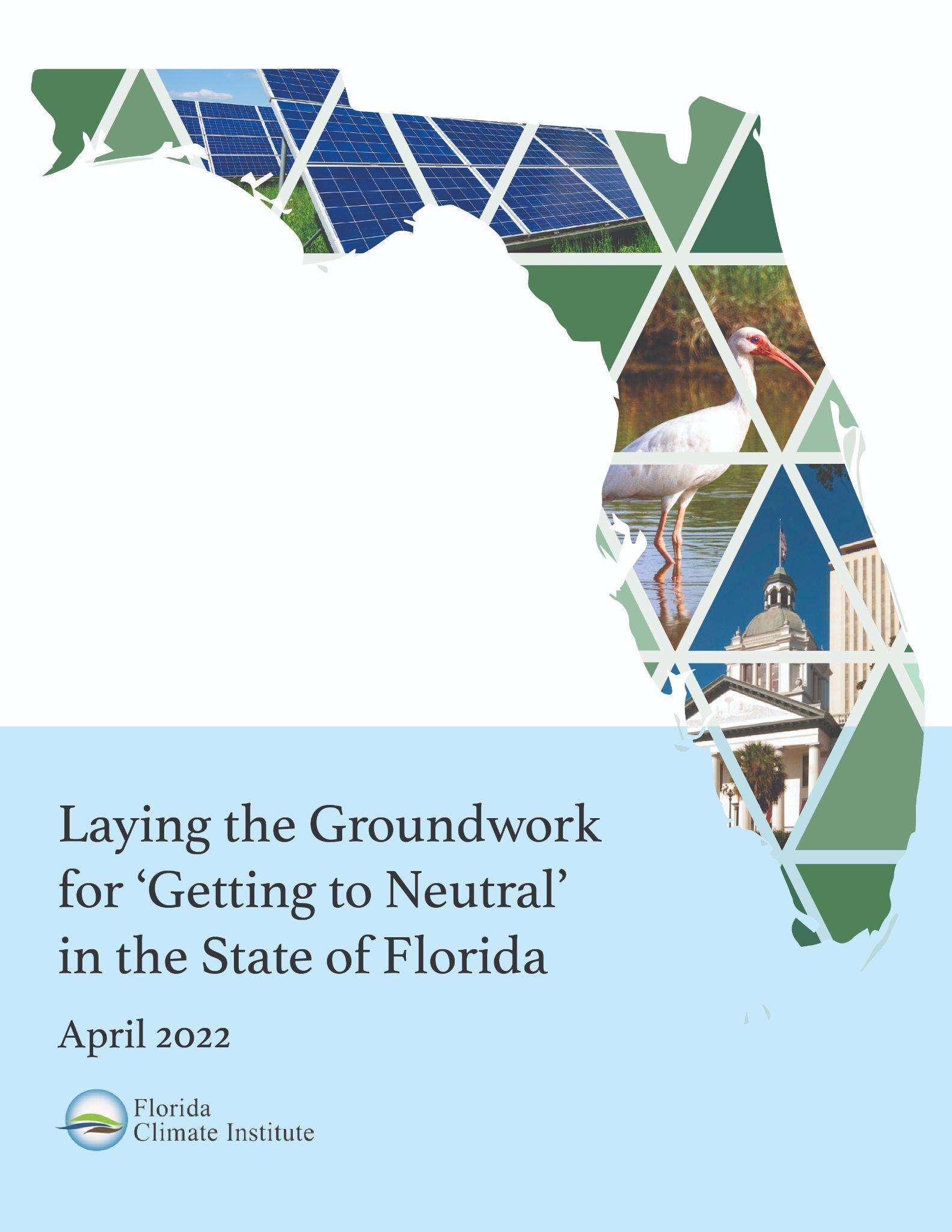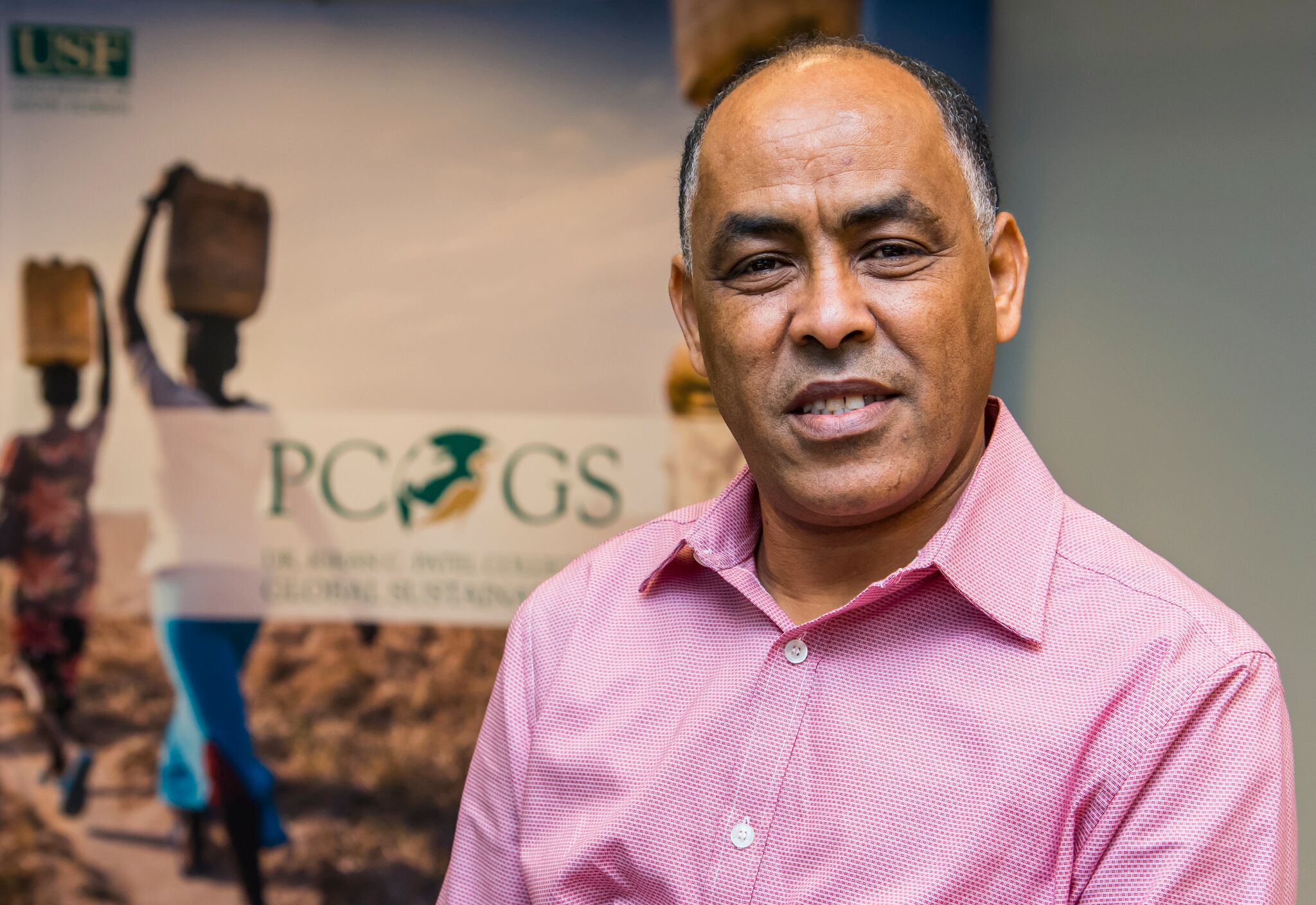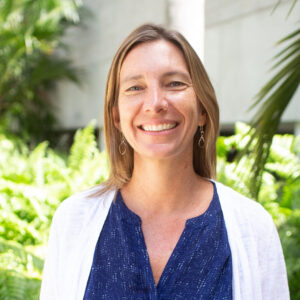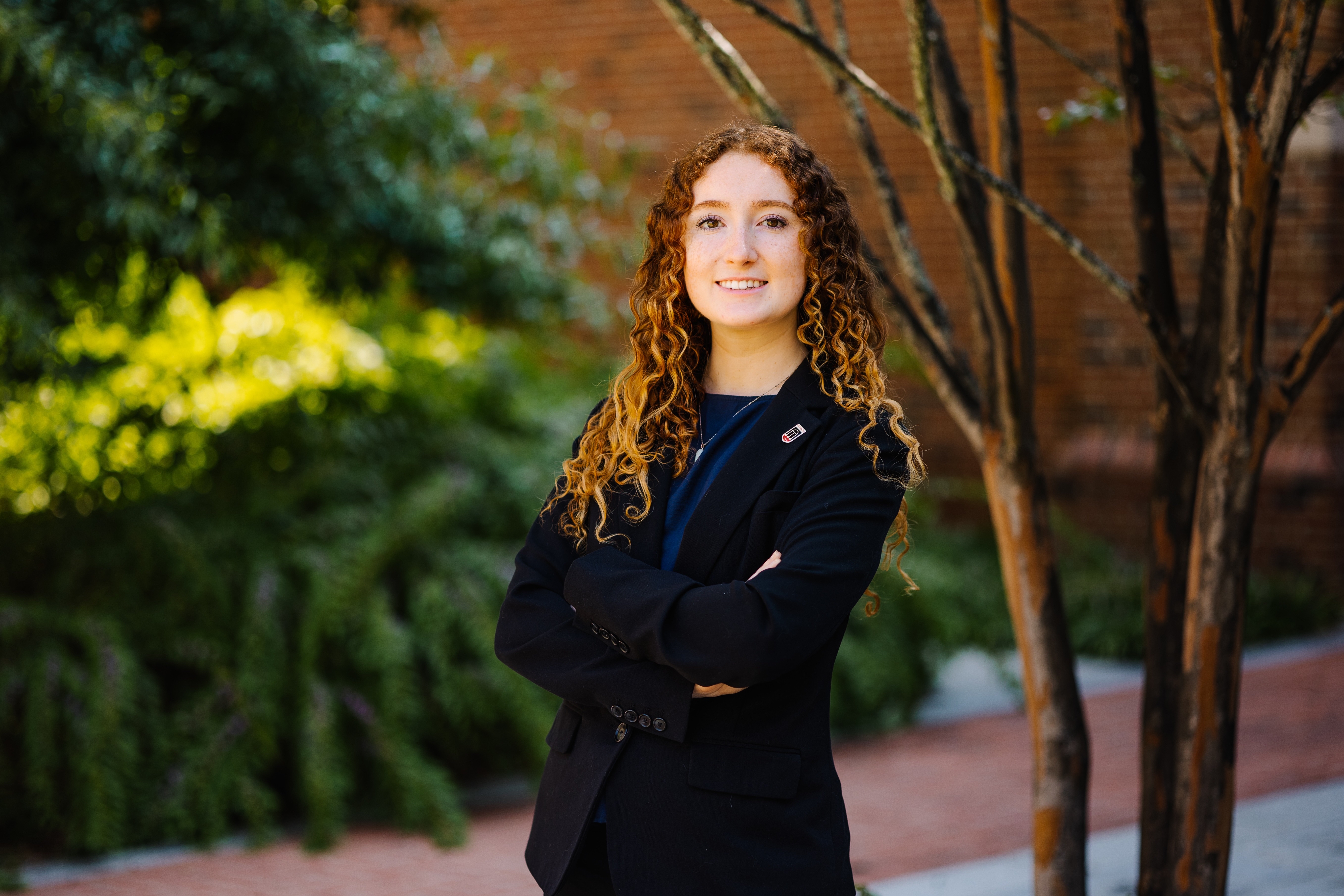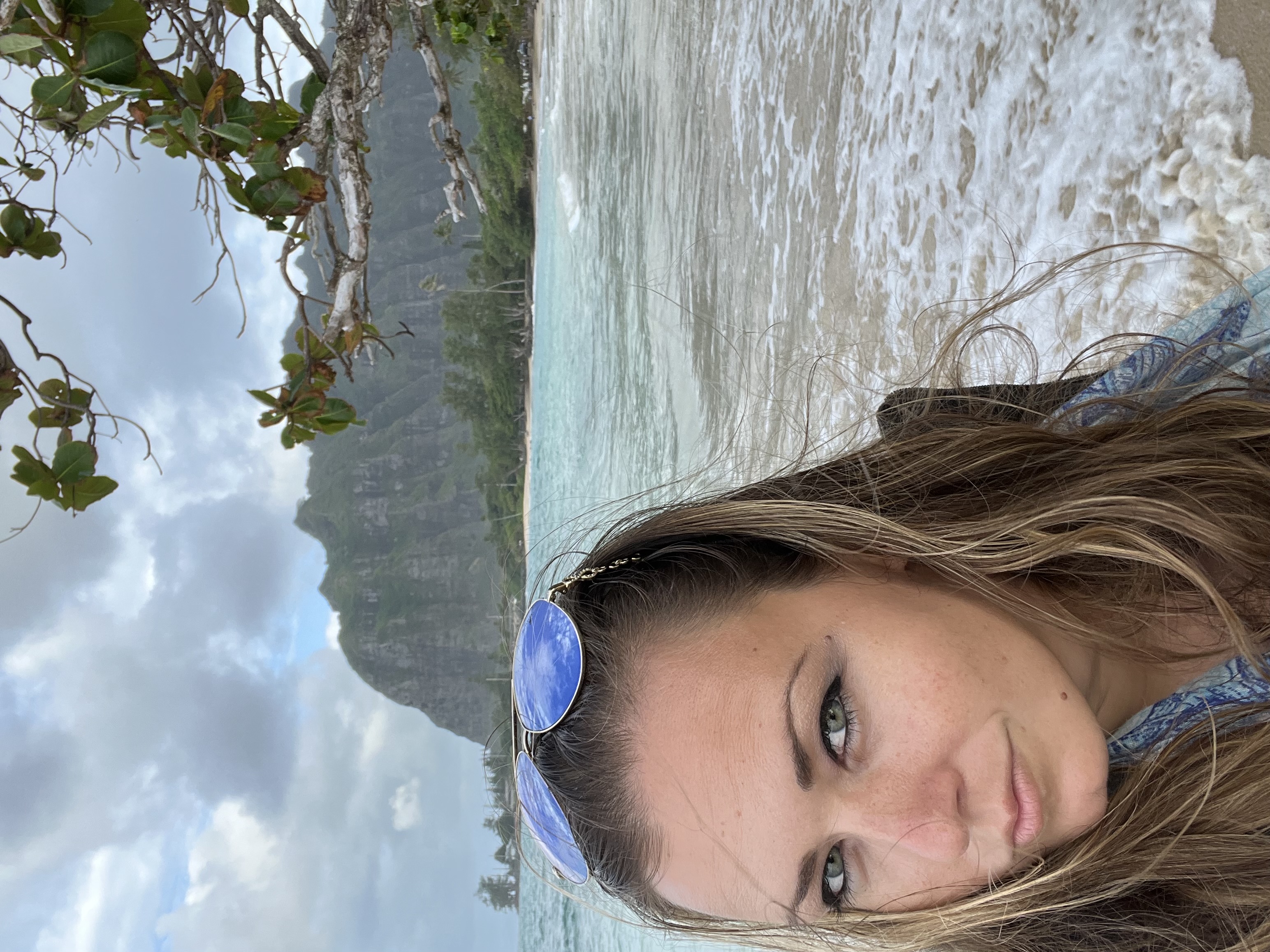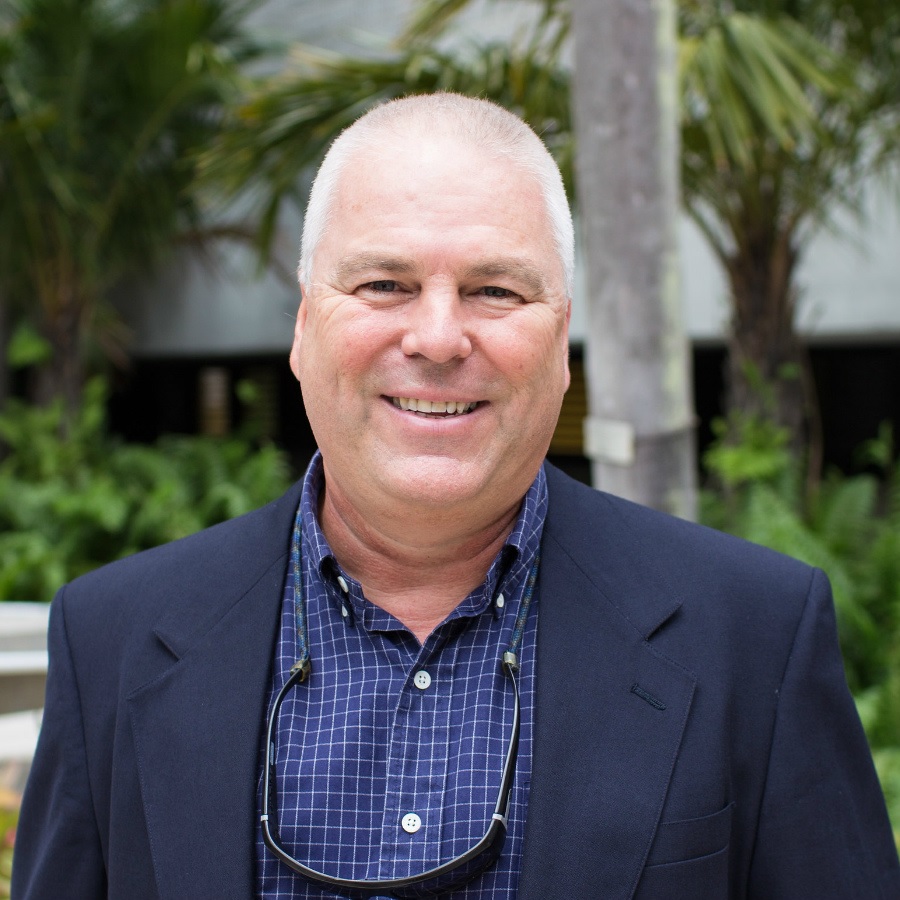News
Laying the Groundwork for 'Getting to Neutral' in the State of Florida
Florida Climate Institute’s Laying the Groundwork for ‘Getting to Neutral’ in the State of Florida report is the product of multiple research-driven collaborative processes compiled together with the purpose of setting a foundation for a net-zero action planning effort in Florida. The first key aspect of the project included performing a greenhouse gas (GHG) inventory of emissions and removals from the years 1990 to 2018, which was accomplished through the resources from the Intergovernmental Panel on Climate Change (IPCC) and the Environmental Protection Agency (EPA). Using the information gathered from the inventory, GHG emissions projections were made under three future scenarios: 1. Business-As-Usual, 2. 100% clean electricity by 2035, and 3. Net-zero emissions by 2050.
This project was developed by a group of university-student interns, faculty members from four Florida universities, researchers, and a private consultant, as well as through the support provided by several federal agencies, departments, and groups such as the United States Environmental Protection Agency (EPA), Florida Department of Environmental Protection (FDEP), the United States Department of Agriculture (USDA), and the National Oceanic and Atmospheric Administration (NOAA).
The report includes an executive summary establishing background information for the paper, a greenhouse gas emissions inventory for the state of Florida from the years 1990 to 2018, greenhouse gas emissions projections for the state of Florida from 2019 to 2050, net-zero action planning efforts for potential emission reductions in the future, and appendices for the inventory and projections.
This project was made possible with generous support provided by the Environmental Defense Fund (EDF) and the VoLo Foundation.
Suggested Citation: Ghebremichael, K., T. Troxler, A. Hernandez, R. Fourqurean, L. Jerome, K. Carroll, D. Moanga, H. Lazzaroni, S. Roy, J. Jenkins, J. McFarlane-Weinstein, A. Kaur, H. Knowles, S. Alvarez, M. Sukop, and J. Obeysekera, (2022). Laying the Groundwork for 'Getting to Neutral' in the State of Florida. Florida Climate Institute.
Report Authors
|
KebreAb Ghebremichael, USF Faculty |
Tiffany Troxler, FIU Faculty |
|
Alyssa Hernandez, FIU Staff/ |
Robert Fourqurean, FSU Student |
|
Lesly Jerome, UF Student Intern |
Kaitlyn Carroll, UGA Student Intern |
|
Diana Moanga, FIU Staff |
Hailey Lazzaroni, FIU Staff |
|
Sukanta Roy, FIU Student Intern |
Jazmyn Jenkins, USF Student Intern |
|
Jonathan McFarlane-Weinstein, |
Ashpreet Kaur, UF Staff |
|
Hal Knowles, UF Faculty |
Sergio Alverez, UCF Faculty |
|
Michael Sukop, FIU Faculty |
Jayantha Obeysekera, FIU Faculty |
Contents
Terms and Conditions: Readers may view, browse, and/or download material for temporary copying purposes only, provided these uses are for noncommercial personal purposes. Except as provided by law, this material may not be further reproduced, distributed, transmitted, modified, adapted, performed, displayed, published, or sold in whole or in part, without proper attribution or written permission from the Florida Climate Institute.
Executive Summary (pg. 6)
1. Summary of Findings
2. Emission Projections (2019-2050)
3. Key Recommendations for Net-Zero Action Planning
Acknowledgements (pg. 17)
Acronyms & Key Terms (pg. 18)
Greenhouse Gas Emissions Inventory (pg. 21)
1. Introduction
2. Overview of Approach and Methodology
3. Summary of Findings
4. Total and Net Emissions
Greenhouse Gas Emissions Projections (pg. 46)
5. Introduction
6. Trends in GHG Emissions Under Different Scenarios
Net-Zero Action Planning (pg. 55)
7. Emission Reduction Potential of Specific Actions to Achieve Net-Zero by 2050
8. GHG Removals & Storage
9. Financial Mechanisms for Reductions, Removals, & Storage of GHGs
10. Potential State Policy Actions for Net-Zero Objectives
Appendices (pg. 100)
 Florida’s Climate: Changes, Variations, & Impacts
Florida’s Climate: Changes, Variations, & Impacts
Edited by Eric P. Chassignet, James W. Jones, Vasubandhu Misra, & Jayantha Obeysekera
Paperback: 632 pages
Publisher: Florida Climate Institute
Printed By: CreateSpace Independent Publishing Platform
Publication Date: November 29, 2017
ISBN-10: 1979091048
ISBN-13: 978-1979091046
Product Dimensions: 7 x 1.4 x 10 inches
Citation: Chassignet, E. P., Jones, J. W., Misra, V., & Obeysekera, J. (Eds.). (2017). Florida's climate: Changes, variations, & impacts. Gainesville, FL: Florida Climate Institute. https://doi.org/10.17125/fci2017
Description:
Florida’s climate has been and continues to be one of its most important assets. It has enabled the growth of many major industries, including tourism and agriculture, which now rank at the top of Florida’s diverse economic activities. Our state’s climate enables its native ecosystems to flourish and attract citizens from around the world. The dependencies of Florida’s society and ecosystems on climate are widely recognized and generally taken for granted. However, we now know that climate around the world is changing. Questions arise about whether or not Florida’s climate is changing, how rapidly these changes might occur, and how Florida may adapt to anticipated changes and help mitigate the rates of change.
This book provides a thorough review of the current state of research on Florida's climate, including physical climate benchmarks; climate prediction, projection, and attribution; and the impacts of climate and climate change on the people and natural resources of Florida. The editors have gathered more than 90 researchers at universities across the state and beyond to address important topics such as sea level rise, water resources, and how climate affects various sectors, including energy, agriculture, forestry, tourism, and insurance. This volume offers accessible, accurate information for students, policymakers, and the general public.
About the Editors:
Eric P. Chassignet is a professor in the Department of Earth, Ocean and Atmospheric Science and director of the Center for Ocean-Atmospheric Prediction Studies at Florida State University. James W. Jones is a distinguished professor emeritus in the Department of Agricultural and Biological Engineering at the University of Florida. Vasubandhu Misra is an associate professor in the Department of Earth, Ocean and Atmospheric Science and the Center for Ocean-Atmospheric Prediction Studies at Florida State University. Jayantha Obeysekera is the chief modeler at the South Florida Water Management District.
Download Book Summary and Key Messages
Contents
Terms and Conditions: Readers may view, browse, and/or download material for temporary copying purposes only, provided these uses are for noncommercial personal purposes. Except as provided by law, this material may not be further reproduced, distributed, transmitted, modified, adapted, performed, displayed, published, or sold in whole or in part, without prior written permission from the Florida Climate Institute.
PDFs of individual chapters are available for download below:
Executive Summary
Eric P. Chassignet, James W. Jones, Vasubandhu Misra, and Jayantha Obeysekera
Citation: Chassignet, E. P., Jones, J. W., Misra, V., & Obeysekera, J. (2017). Executive summary. In E. P. Chassignet, J. W. Jones, V. Misra, & J. Obeysekera (Eds.), Florida's climate: Changes, variations, & impacts (iii-viii). Gainesville, FL: Florida Climate Institute. https://doi.org/10.17125/fci2017.exsum
Societal Challenges Associated with Climate and Climate Change in Florida
1. Human Dimensions and Communication of Florida's Climate
Peter J. Jacques, Kenneth Broad, William Butler, Christopher Emrich, Sebastian Galindo, Claire Knox, Keith W. Rizzardi, and Kathryn Ziewitz
Citation: Jacques, P. J., Broad, K., Butler, W., Emrich, C., Galindo, S., Knox, C., et al. (2017). Human dimensions and communication of Florida's climate. In E. P. Chassignet, J. W. Jones, V. Misra, & J. Obeysekera (Eds.), Florida's climate: Changes, variations, & impacts (pp. 1–50). Gainesville, FL: Florida Climate Institute. https://doi.org/10.17125/fci2017.ch01
2. Florida Land Use and Land Cover Change in the Past 100 Years
Michael I. Volk, Thomas S. Hoctor, Belinda B. Nettles, Richard Hilsenbeck, Francis E. Putz, and Jon Oetting
Citation: Volk, M. I., Hoctor, T. S., Nettles, B. B., Hilsenbeck, R., Putz, F. E., & Oetting, J. (2017). Florida land use and land cover change in the past 100 years. In E. P. Chassignet, J. W. Jones, V. Misra, & J. Obeysekera (Eds.), Florida's climate: Changes, variations, & impacts (pp. 51–82). Gainesville, FL: Florida Climate Institute. https://doi.org/10.17125/fci2017.ch02
3. Implications of Climate Change on Florida's Water Resources
Jayantha Obeysekera, Wendy Graham, Michael C. Sukop, Tirusew Asefa, Dingbao Wang, Kebreab Ghebremichael, and Benjamin Mwashote
Citation: Obeysekera, J., Graham, W., Sukop, M. C., Asefa, T., Wang, D., Ghebremichael, K., et al. (2017). Implications of climate change on Florida's water resources. In E. P. Chassignet, J. W. Jones, V. Misra, & J. Obeysekera (Eds.), Florida's climate: Changes, variations, & impacts (pp. 83–124). Gainesville, FL: Florida Climate Institute. https://doi.org/10.17125/fci2017.ch03
4. Climate Change Impacts on Human Health
Song Liang, Kristina Kintziger, Phyllis Reaves, and Sadie Ryan
Citation: Liang, S., Kintziger, K., Reaves, P., & Ryan, S. J. (2017). Climate change impacts on human health. In E. P. Chassignet, J. W. Jones, V. Misra, & J. Obeysekera (Eds.), Florida's climate: Changes, variations, & impacts (pp. 125–152). Gainesville, FL: Florida Climate Institute. https://doi.org/10.17125/fci2017.ch04
5. Climate Change Impacts on Florida's Energy Supply and Demand
Wendell A. Porter and Hal Knowles III
Citation: Porter, W. A., & Knowles III, H. (2017). Climate change impacts on Florida's energy supply and demand. In E. P. Chassignet, J. W. Jones, V. Misra, & J. Obeysekera (Eds.), Florida's climate: Changes, variations, & impacts (pp. 153–177). Gainesville, FL: Florida Climate Institute. https://doi.org/10.17125/fci2017.ch05
6. Climate Change Impacts on Insurance in Florida
Lorilee Medders
Citation: Medders, L. (2017). Climate change impacts on insurance in Florida. In E. P. Chassignet, J. W. Jones, V. Misra, & J. Obeysekera (Eds.), Florida's climate: Changes, variations, & impacts (pp. 179–207). Gainesville, FL: Florida Climate Institute. https://doi.org/10.17125/fci2017.ch06
7. Climate Change Impacts on Law and Policy in Florida
Thomas Ruppert and Erin L. Deady
Citation: Ruppert, T., & Deady, E. L. (2017). Climate change impacts on law and policy in Florida. In E. P. Chassignet, J. W. Jones, V. Misra, & J. Obeysekera (Eds.), Florida's climate: Changes, variations, & impacts (pp. 209–234). Gainesville, FL: Florida Climate Institute. https://doi.org/10.17125/fci2017.ch07
Economic and Environmental Challenges Associated with Climate Change in Florida
8. Climate Change Impacts and Adaptation in Florida's Agriculture
Young Gu Her, Kenneth J. Boote, Kati W. Migliaccio, Clyde Fraisse, David Letson, Odemari Mbuya, Aavudai Anandhi, Hongmei Chi, Lucy Ngatia, and Senthold Asseng
Citation: Her, Y. G., Boote, K. J., Migliaccio, K. W., Fraisse, C., Letson, D., Mbuya, O., et al. (2017). Climate change impacts and adaptation in Florida's agriculture. In E. P. Chassignet, J. W. Jones, V. Misra, & J. Obeysekera (Eds.), Florida's climate: Changes, variations, & impacts (pp. 235–267). Gainesville, FL: Florida Climate Institute. https://doi.org/10.17125/fci2017.ch08
9. Managing Florida's Plantation Forests in a Changing World
Timothy A. Martin, Damian C. Adams, Matthew J. Cohen, Raelene M. Crandall, Carlos A. Gonzalez-Benecke, Jason A. Smith, and Jason G. Vogel
Citation: Martin, T. A., Adams, D. C., Cohen, M. J., Crandall, R. M., Gonzalez-Benecke, C. A., Smith, J. A., et al. (2017). Managing Florida's plantation forests in a changing climate. In E. P. Chassignet, J. W. Jones, V. Misra, & J. Obeysekera (Eds.), Florida's climate: Changes, variations, & impacts (pp. 269–295). Gainesville, FL: Florida Climate Institute. https://doi.org/10.17125/fci2017.ch09
10. Florida Tourism
Julie Harrington, Hongmei Chi, and Lori Pennington Gray
Citation: Harrington, J., Chi, H., & Gray, L. P. (2017). Florida tourism. In E. P. Chassignet, J. W. Jones, V. Misra, & J. Obeysekera (Eds.), Florida's climate: Changes, variations, & impacts (pp. 297–309). Gainesville, FL: Florida Climate Institute. https://doi.org/10.17125/fci2017.ch10
11. Adaptation of Florida's Urban Infrastructure to Climate Change
Frederick Bloetscher, Serena Hoermann, and Leonard Berry
Citation: Bloetscher, F., Hoermann, S., & Berry, L. (2017). Adaptation of Florida's urban infrastructure to climate change. In E. P. Chassignet, J. W. Jones, V. Misra, & J. Obeysekera (Eds.), Florida's climate: Changes, variations, & impacts (pp. 311–338). Gainesville, FL: Florida Climate Institute. https://doi.org/10.17125/fci2017.ch11
12. Climate Change Impacts on Florida's Biodiversity and Ecology
Beth Stys, Tammy Foster, Mariana M.P.B. Fuentes, Bob Glazer, Kimberly Karish, Natalie Montero, and Joshua S. Reece
Citation: Stys, B., Foster, T., Fuentes, M. M. P. B., Glazer, B., Karish, K., Montero, N., et al. (2017). Climate change impacts on Florida's biodiversity and ecology. In E. P. Chassignet, J. W. Jones, V. Misra, & J. Obeysekera (Eds.), Florida's climate: Changes, variations, & impacts (pp. 339–389). Florida Climate Institute. https://doi.org/10.17125/fci2017.ch12
13. Florida's Oceans and Marine Habitats in a Changing Climate
Steven Morey, Marguerite Koch, Yanyun Liu, and Sang-Ki Lee
Citation: Morey, S., Koch, M., Liu, Y., & Lee, S. - K. (2017). Florida's oceans and marine habitats in a changing climate. In E. P. Chassignet, J. W. Jones, V. Misra, & J. Obeysekera (Eds.), Florida's climate: Changes, variations, & impacts (pp. 391–425). Gainesville, FL: Florida Climate Institute. https://doi.org/10.17125/fci2017.ch13
14. Climate Change Impacts on Florida's Fisheries and Aquaculture Sectors and Options for Mitigation
Kai Lorenzen, Cameron Ainsworth, Shirley Baker, Luiz Barbieri, Edward Camp, Jason Dotson, and Sarah Lester
Citation: Lorenzen, K., Ainsworth, C. H., Baker, S. M., Barbieri, L. R., Camp, E. V., Dotson, J. R., et al. (2017). Climate change impacts on Florida's fisheries and aquaculture sectors and options for adaptation. In E. P. Chassignet, J. W. Jones, V. Misra, & J. Obeysekera (Eds.), Florida's climate: Changes, variations, & impacts (pp. 427–455). Gainesville, FL: Florida Climate Institute. https://doi.org/10.17125/fci2017.ch14
Florida's Physical Climate: Past, Present, and Future
15. Paleoclimate of Florida
Albert C. Hine, Ellen E. Martin, John M. Jaeger, and Mark Brenner
Citation: Hine, A. C., Martin, E. E., Jaeger, J. M., & Brenner, M. (2017). Paleoclimate of Florida. In E. P. Chassignet, J. W. Jones, V. Misra, & J. Obeysekera (Eds.), Florida's climate: Changes, variations, & impacts (pp. 457–484). Gainesville, FL: Florida Climate Institute. https://doi.org/10.17125/fci2017.ch15
16. Terrestrial and Ocean Climate of the 20th Century
Vasubandhu Misra, Christopher Selman, Amanda J. Waite, Satish Bastola, and Akhilesh Mishra
Citation: Misra, V., Selman, C., Waite, A. J., Bastola, S., & Mishra, A. (2017). Terrestrial and ocean climate of the 20th century. In E. P. Chassignet, J. W. Jones, V. Misra, & J. Obeysekera (Eds.), Florida's climate: Changes, variations, & impacts (pp. 485–509). Gainesville, FL: Florida Climate Institute. https://doi.org/10.17125/fci2017.ch16
17. Florida Climate Variability and Prediction
Ben P. Kirtman, Vasubandhu Misra, Robert J. Burgman, Johnna Infanti, and Jayantha Obeysekera
Citation: Kirtman, B. P., Misra, V., Burgman, R. J., Infanti, J., & Obeysekera, J. (2017). Florida climate variability and prediction. In E. P. Chassignet, J. W. Jones, V. Misra, & J. Obeysekera (Eds.), Florida's climate: Changes, variations, & impacts (pp. 511–532). Gainesville, FL: Florida Climate Institute. https://doi.org/10.17125/fci2017.ch17
18. Future Climate Change Scenarios for Florida
Ben P. Kirtman, Vasubandhu Misra, Aavudai Anandhi, Diane Palko, and Johnna Infanti
Citation: Kirtman, B. P., Misra, V., Anandhi, A., Palko, D., & Infanti, J. (2017). Future climate change scenarios for Florida. In E. P. Chassignet, J. W. Jones, V. Misra, & J. Obeysekera (Eds.), Florida's climate: Changes, variations, & impacts (pp. 533–555). Gainesville, FL: Florida Climate Institute. https://doi.org/10.17125/fci2017.ch18
19. Sea Level Rise
Gary Mitchum, Andrea Dutton, Don P. Chambers, and Shimon Wdowinski
Citation: Mitchum, G., Dutton, A., Chambers, D. P., & Wdowinski, S. (2017). Sea level rise. In E. P. Chassignet, J. W. Jones, V. Misra, & J. Obeysekera (Eds.), Florida's climate: Changes, variations, & impacts (pp. 557–578). Gainesville, FL: Florida Climate Institute. https://doi.org/10.17125/fci2017.ch19
20. Climate and Weather Extremes
Jennifer M. Collins, Charles H Paxton, Thomas Wahl, and Christopher T. Emrich
Citation: Collins, J. M., Paxton, C. H., Wahl, T., & Emrich, C. T. (2017). Climate and weather extremes. In E. P. Chassignet, J. W. Jones, V. Misra, & J. Obeysekera (Eds.), Florida's climate: Changes, variations, & impacts (pp. 579–615). Gainesville, FL: Florida Climate Institute. https://doi.org/10.17125/fci2017.ch20
About Climate Change, Climate Variability, and Florida
To submit a question, please email This email address is being protected from spambots. You need JavaScript enabled to view it..
General |
For Young Scientists |
Climate & Florida |
Sea Level Rise |
Beaches & Coastal Resilience |
Ports & Navigational Channels |
General
What's the difference between weather and climate?
Both weather and climate rely on observations of temperature, pressure, sunlight, clouds, rain, and snow. The main difference between the two is the time scale over which the conditions are described. Weather is generally a snapshot of the atmosphere at a single time or over a few days. Climate generally refers to conditions spanning months, years, and even decades. One way to remember the difference between weather and climate is: Weather tells you what to wear on any given day; climate tells you what wardrobe to own.
What's the difference between global warming, climate change, and climate variability?
"Global warming" refers to an increase in Earth's annually averaged air temperature near the surface. Thermometer readings are collected from many thousands of weather stations around the world—over land and ocean—and then used to produce a global average temperature for each year. The resulting series of annual averages of global temperature from 1880 to 2012 show that Earth has warmed by 1.5°F (0.85°C).[1] Most of that warming has occurred since 1976.
"Climate change" is a broadly inclusive term that refers to a long-term (decades to centuries) change in any of a number of environmental conditions for a given place and time—such as temperature, rainfall, humidity, cloudiness, wind and air circulation patterns, etc. These oscillations and other similar phenomena can influence weather and climate patterns around the globe.
"Climate variability" refers to short-term (weeks to decades) changes in some of these same environmental conditions for a given place and time. Climate variability is often the result of natural oscillations in Earth's climate system — such as the El Niño-Southern Oscillation (ENSO), the North Atlantic Oscillation (NAO), the Pacific-North American Teleconnection Pattern, etc. These oscillations and other similar phenomena can influence weather and climate patterns around the globe.
Source: NOAA Climate.gov Global Warming FAQs
Are humans causing or contributing to global warming?
Yes, human activities have increased the abundance of heat-trapping gases in the atmosphere, which a large majority of climate scientists agree is the main reason for the 1.5°F (0.85°C) rise in average global temperature since 1880. Carbon dioxide is the heat-trapping gas primarily responsible for the rise but methane, nitrous oxide, ozone, and various other very long-lived heat-trapping gases also contribute. Carbon dioxide is of greatest concern because its rate of increase is exerting a larger overall warming influence than all of those other gases combined, and because carbon dioxide levels in the atmosphere will remain elevated for centuries unless we implement a way to remove carbon dioxide from the atmosphere effectively and economically. Most carbon dioxide from human activities is released from burning coal and other fossil fuels. Other human activities, including deforestation, biomass burning, and cement production also produce carbon dioxide.
Source: NOAA Climate.gov Global Warming FAQs
What's the difference between a projection, forecast, prediction, and scenario?
The term "projection" is used in two senses in the climate change literature. In general usage, a projection can be regarded as any description of the future and the pathway leading to it. However, a more specific interpretation has been attached to the term "climate projection" by the IPCC when referring to model-derived estimates of future climate.
When a projection is branded "most likely" it becomes a forecast or prediction. A forecast is often obtained using deterministic models, possibly a set of these, outputs of which can enable some level of confidence to be attached to projections.
A scenario is a coherent, internally consistent and plausible description of a possible future state of the world. It is not a forecast; rather, each scenario is one alternative image of how the future can unfold. A projection may serve as the raw material for a scenario, but scenarios often require additional information (e.g., about baseline conditions). A set of scenarios is often adopted to reflect, as well as possible, the range of uncertainty in projections. Other terms that have been used as synonyms for scenario are "characterisation", "storyline" and "construction".
How can Earth's climate be accurately predicted years or decades in the future when weather cannot be accurately predicted more than 2 weeks from now?
Weather forecasters look at initial conditions and then make short-term deterministic predictions about future events (from minutes to days, to less than 2 weeks). Due to the fluid and chaotic nature of the atmosphere, it is impossible to make accurate deterministic predictions about weather events more than 2 weeks in the future. Climate forecasters look at the state of the key controlling parameters of the climate system and then make long-term probabilistic predictions about future conditions (from more than 2 weeks to years, to decades). People do this all the time with high reliability. For example, while you don't know what the weather will be a like on a given day in Washington, D.C., in the year 2020, you can be confident that temperatures will be warmer in the summer than in the winter.
Another way to understand the differences between deterministic and probabilistic predictions is to consider how other types of experts use them. For example, a doctor may have a hard time determining exactly when a particular overweight, middle-aged person who smokes cigarettes is going to die. But a life insurance agent can easily make a probabilistic prediction of the person's life expectancy based on the average life spans of millions of overweight, middle-aged people who smoked.
Source: NOAA Climate.gov Global Warming FAQs
What is an "extreme event"? Is there evidence that global warming has caused or contributed to any particular extreme event?
An extreme event is a time and place in which weather, climate, or environmental conditions — such as temperature, precipitation, drought, or flooding — rank above a threshold value near the upper or lower ends of the range of historical measurements. Though the threshold is arbitrary, some scientists define extreme events as those that occur in the highest or lowest 5% or 10% of historical measurements.
Human-caused climate change is not the sole cause of any single extreme event. However, changes in the intensity or frequency of extremes may be influenced by human-caused climate change. Heat waves will tend to be a bit hotter— both the daily high and daily low temperatures. And, because a warmer atmosphere holds more water vapor, precipitation events will tend to be heavier (as measured by total rainfall or snowfall). These are just two examples of how extreme events are becoming more extreme.
Establishing causes of a specific extreme event can be difficult and requires case-specific methods. Scientists can assess whether a specific event (e.g., the 2012 U.S. drought, or the storm surge from Superstorm Sandy) has become more or less likely, or stronger or weaker, as a consequence of human-caused climate change. In nineteen recent analyses of twelve extreme events in 2012, scientists found that some events had direct ties to climate change, while others did not.
Source: NOAA Climate.gov Global Warming FAQs
Can we slow or even reverse global warming?
In principle, we can slow the rate of global warming by slowing the emission rates of heat-trapping gases—mainly carbon dioxide—and black carbon aerosol to the atmosphere. Some continued warming is inevitable. Stabilizing global temperature at its current level would be very difficult because it would require cutting the emission of heat-trapping gases all the way to zero. If and when zero emissions becomes possible, temperatures won't start to recover until heat-trapping gases are actually removed from the atmosphere. Such removal happens naturally on time scales ranging from less than a year (e.g., black carbon aerosol) to centuries (e.g., carbon dioxide). Additionally, technical means exist to remove some heat-trapping gases (including carbon dioxide) from the atmosphere.
Ultimately, global warming could be reversed by returning the abundance of heat-trapping gases in the atmosphere to pre-industrial levels (circa 1750). The challenge in slowing or reducing global warming is finding a way to make these changes on a global scale that is technically, economically, socially, and politically viable. Reducing our emission of carbon dioxide has the added benefit of slowing the rate at which humans are making the ocean's water more acidic, which is a threat to shell-forming organisms and the marine food chain.
In response to a request from the U.S. Congress, the U.S. National Academy of Sciences published a series of peer-reviewed reports, titled America's Climate Choices, to provide authoritative analyses to inform and guide responses to climate change across the nation. Relevant to this question, the NAS report titled Limiting the Magnitude of Future Climate Change explains policies that could be adopted to slow or even reverse global warming. The report says, "Meeting internationally discussed targets for limiting atmospheric greenhouse gas concentrations and associated increases in global average temperatures will require a major departure from business as usual in how the world uses and produces energy."
Alternative methods to slow or reduce global warming have been proposed that are, collectively, known as "climate engineering" or "geo-engineering." Some geo-engineering proposals involve cooling Earth's surface by injecting reflective particles into the upper atmosphere to scatter and reflect sunlight back to space. Other proposals involve seeding the oceans with iron to stimulate large-scale phytoplankton blooms, thereby drawing down carbon dioxide out of the atmosphere through photosynthesis. Such methods could work, in principle, but many climate scientists oppose undertaking geo-engineering until we have a much better understanding of the possible side effects. Additionally, there are unresolved legal and ethical issues surrounding geo-engineering.
Given these concerns, the American Meteorological Society published a position paper (readopted in January 2013) in which it said: "...research to date has not determined whether there are large-scale geo-engineering approaches that would produce significant benefits, or whether those benefits would substantially outweigh the detriments. Indeed, geo-engineering must be viewed with caution because manipulating the Earth system has considerable potential to trigger adverse and unpredictable consequences."
Source: NOAA Climate.gov Global Warming FAQs
end faq
For Young Scientists
When did climate change/global warming start? How could scientists tell it was starting?
Man-made or anthropogenic climate change is generally considered to start with the industrial revolution, around the middle of the 19th century (1850). It was at this time that big factories started to flourish, and they needed an energy source to fire the steel mills and provide power. Coal was the big fuel at first and used in the factories, but also to generate electric power once electricity became available. About that time oil was also discovered in Pennsylvania and became another source of energy. All this burning of coal, oil, and natural gas (fossil fuels) increased the concentration of carbon dioxide in the atmosphere over natural levels.
In 1896 Svante Arrhenius, a Swedish scientist, was the first to publish the theory that excess carbon dioxide in the atmosphere will absorb more long wave or infrared radiation, leading to a general warming of the planet.
With the two world wars and most research effort being put into weather prediction, not a lot more was learned about global warming in the first half of the 20th century. In 1958 Charles Keeling began taking very accurate measurements of CO2 in the atmosphere on the top of Mauna Loa in the Hawaiian Islands. This was the first continuous series of accurate measurements of CO2 in the atmosphere. Concentrations were around 315 parts per million (ppm) in 1958, but have risen steadily since then until they are over 400 ppm today.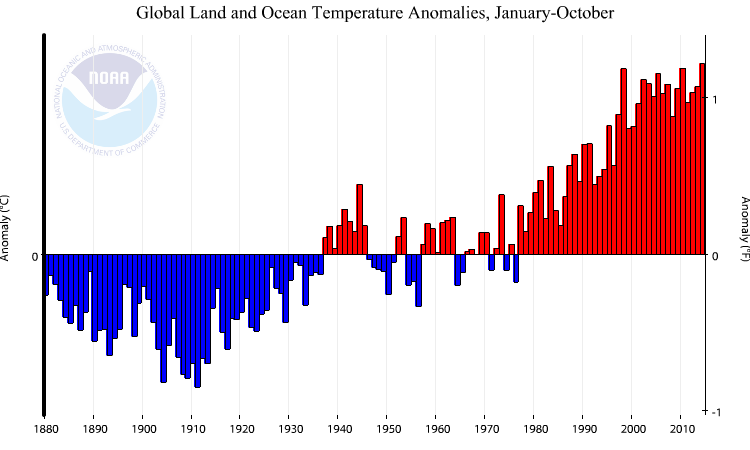
We did not have widespread and accurate temperature measurements around the globe prior to 1850 or so. However, we do have pretty good records since 1900 and they show a corresponding increase in the global average temperature of about 0.8 degrees Celsius, or nearly 2 degrees Fahrenheit. Scientists also see changes in ocean temperatures, snow and ice cover, sea ice, and rising sea levels that all point to a general warming of the planet.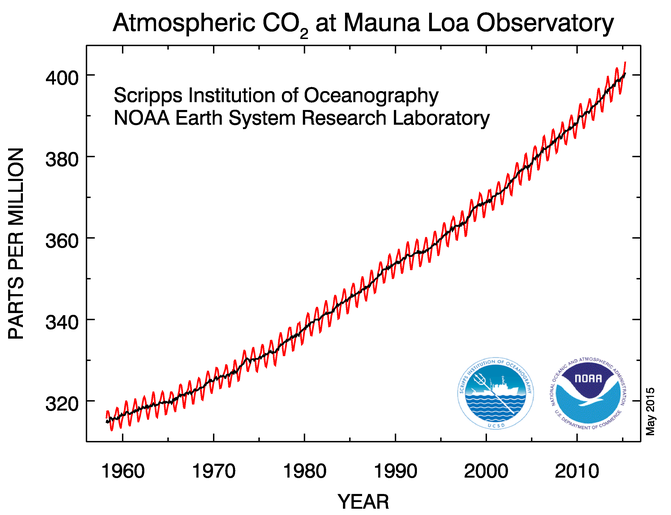
How has the problem changed over the last 10, 5, 2 years?
The short answer is not much. Some countries like the United States and European Union countries have reduced emissions of C02 in recent years (mostly due to the availability of natural gas from fracking in the U.S.), others like China and India continue to increase greatly each year. Even with reduced emissions, we are still putting a bunch of excess C02 in the atmosphere and concentrations continue to rise. Climate science has made substantial advances in the last decade, so we know better how things like the how Arctic and Antarctic ice are reacting, along with changes in heavy rainfall, droughts, and other extreme weather. Still, society as a whole has not made any real strides in stopping or slowing climate change.
With President Obama's support, the EPA has proposed guidelines that will cut CO2 emissions from power plants by 30% by 2030. We have also reached an agreement with China, the world’s largest source of CO2, that they will reach their peak emissions by 2030. This is a great start to the worldwide summit to be held in Paris later this year where each nation will pledge their own cuts.
As for the climate itself, the rate of global warming has slowed since 1998 in what is now known as the "global warming hiatus". Skeptics point to this hiatus as proof that climate change is not that big a deal. Climate science has shown there is around a 30-year cycle in warming and cooling of the planet, and being in the cooling phase of this cycle is what has slowed global warming. Other studies suggest that the deep ocean is absorbing some of the excess heat. Regardless, 9 of the worlds 10 warmest years have occurred since 2000 and most scientists agree that the cycle will return to a more rapid warming soon.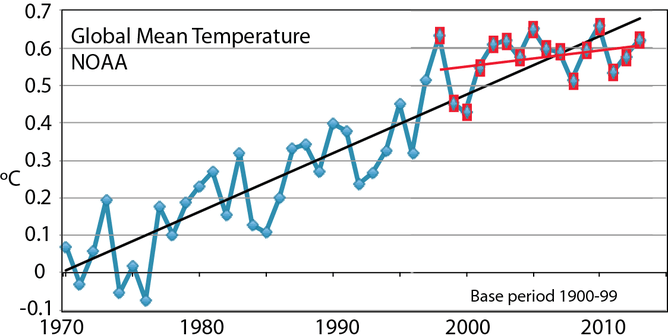
Are there opposing viewpoints about the situation?
On some things the science is very clear and there is nearly universal agreement among scientists. There is no debate that humans have changed the amount of C02 and other greenhouse gasses in the atmosphere. All scientists also agree that the world has been warming over the last century and that the greenhouse gasses play a part. A vast majority of scientists also accept that humans have played the largest role in this warming, but some question if natural variations or cycles are not also a cause.
Where disagreement becomes stronger is in the details, where the science is not as well established and there is considerable uncertainty. Questions like just how sensitive is the climate system to C02? Are extreme events changing and by how much? Will sea level continue to rise at the current rate, or get much higher? How will temperature, rainfall, extreme events change where I live? And the big one, will climate change be slow enough for the planet, plants and animals, and us to easily adapt, or will it be more abrupt and cause major disruptions to society and catastrophic ecological consequences? Will the world be able to change how it uses energy enough to make a difference, and should we? Questions like these are where the real debate lies and science does not give us concrete answers, yet.
Are there any policies or laws in place that are meant to address the issue?
Before we talk about policies, let me explain the difference between adaptation and mitigation. Adaptation refers to how we react to the current and projected changes in climate, how we deal with the reality of climate change. Measures like protecting and relocating coastal communities in the face or rising sea levels or changing farming practices to deal with more heat and variations in rainfall are examples of adaptation. Mitigation means trying to stop or slow climate change by reducing our emissions of greenhouse gases.
On the national level, climate change policies mostly deal with mitigation. The only real policy in place is the EPA's requirement that emissions from power plants be cut by 30% by 2030. President Obama also rolled out his Climate Action Plan in November of 2014, including an agreement with China where we pledge to cut all carbon emissions by 28% by the year 2025. Some say these goals are overly ambitious and will harm the economy and our way of life. Others say they are not enough and will not make much difference in slowing climate change. Either way, many state governments and members of the House of Representatives and the Senate will oppose these measures.
On the State level, Florida's Governor Rick Scott does not view climate change as a pressing issue. He made national news recently for allegedly banning the use of the terms "climate change" and "global warming" in the various State agencies.
In spite of this culture, there is a lot good work going on in the State concerning climate change, mostly from the adaptation side. Florida Department of Transportation factors in rising sea levels in the design of new or upgraded roads and bridges. We are working with the Department of Health to assess how climate and human health and disease are related and how that can change in the future. On the local level, the four Southeast Florida coastal counties have formed the Southeast Florida Regional Climate Compact that follow common standards for upgrading roads, utilities, and other infrastructure as well a community planning and zoning.
How can the average Floridian help reduce climate change/global warming?
There is actually a lot that the average citizen can do to reduce their contribution to carbon dioxide emissions and climate change. The first thing is to conserve energy... do everything you can to make your home more energy efficient, use heating air conditioning, hot water less, try to take fewer trips in the car or combine trips and own a fuel efficient vehicle. Other bigger steps are to install solar energy panels on your home to help provide electricity and heat water. Another overlooked step that also has beneficial health impacts is to eat less meat. Beef, poultry, pork, etc. take much more energy to raise than vegetable crops, especially since grains and grasses that feed the animals have to be grown also, which takes energy.
Will climate change ever bring benefit to some areas?
This may be the best question of the bunch. Some agricultural areas will likely see benefits from longer growing seasons, more rainfall, and even more CO2 in the atmosphere can benefit some crops as plants use it for photosynthesis. With human health, far more people die worldwide from extreme cold than from heat waves. A shift towards a warmer planet may actually prevent some deaths. These are just some examples, I am sure there are many more. Too often the news media and even climate research itself focuses on the negatives of climate change, disregarding the possible positive outcomes.
Could climate change/global warming ever wipe us out?
No, not in our lifetime anyway and its very unlikely that it would in your future children's or grandchildren's lifetime either. Human civilization faces a whole host of challenges and stressors going forward the next several hundred years and climate change is only one of them. Ever increasing population, degradation of the environment, clean water supply, availability and security of food, availability of energy, unstable global economy, war and terrorism, disease and antibiotic resistant bacteria are all very serious concerns that could have a great impact on human society. And all of these threats are interrelated, influencing the others. Climate change could very well make many or all of these problems worse, but they will still be problems with or without the influence of climate change.
Many scientists also believe that the earth/ocean/atmosphere/ice system wants to find a balance, and that it will adjust to the excess greenhouse gasses without too drastic a change. Others believe there may be a "tipping point", where too high a concentration of greenhouse gasses will lead to runaway warming. That being said, the most sophisticated computer climate models around the world predict various degrees of warming by the end of this century, but none of them predict runaway climate change.
Also keep in mind that the earth's climate has seen more drastic changes in its history than what is occurring now from global warming. During one prehistoric period the earth was completely frozen and covered in ice, in others the poles were ice-free and the ocean warm near the North Pole. Most recently, we came out of the last ice age about 12,000 years ago and humans survived through it. Due to subtle changes in the earth's orbit and tilt, we will likely enter another ice age sometime in the next 10,000 years.
Enough doom and gloom...human beings are the most adaptable creatures this world has ever seen and we have great potential to solve and deal with problems through technology and working together towards the common good. Sooner or later this will be the case with our energy use and climate change.
end faq
Climate & Florida
How much has the temperature of Florida and the southeastern U.S.A. risen over the last century?
The southeastern U.S.A., including northern and central Florida, is one region of the globe that has not experienced any appreciable warming from greenhouse gases. Our historic data records show that the climate of the Southeast was characterized by relatively warm decades in the 1920's, 1930's, and 1950's and cooler decades in the 1960's through 1980's. In northern Alabama and northern Georgia, some of the hottest years on record and many daily heat records occurred in the 1930's.
In Florida, the greatest impact that man has had on climate is through changing the land surface. Temperatures have risen along the southeastern Florida coast by over 1°F in the last 40 years, especially in the summer months. Much of this can be attributed to urban development, where cities built of concrete and asphalt now absorb and hold more heat than the natural environment they replaced. Similar trends are observed in other urbanized areas, such as Jacksonville, Tampa, Orlando, and the I-4 corridor. Other changes to the land surface have also impacted the local climate, such as the draining of vast wetlands and their conversion to sugar cane fields around Belle Glade on the south shore of Lake Okeechobee.
Will temperatures rise in the coming decades?
It is difficult to determine if the Southeast will continue to lag behind the rest of the globe with respect to rising temperatures. While global climate models have some skill at predicting changes to the global average temperature, they have a much harder time predicting regional or local changes. Our geography and proximity to the Gulf of Mexico and Atlantic Ocean suggests that temperature changes will be less here in Florida than in other parts of North America.
Have we seen an increase in the number or strength of hurricanes?
Perhaps the greatest weather- and climate-related risk to people and property in Florida is hurricanes. The IPCC report states there is a "low confidence" (less than 20%) that we have seen a human-caused increase in intense hurricanes, which is even less confident than the 2007 assessment. Influencing this conclusion is a widely cited 2010 review paper published by ten of the leading hurricane experts, "Tropical Cyclones and Climate Change." These authors found there was no significant increase in landfalling storms and that it is uncertain whether the changes observed in past hurricane activity were outside the variability expected from natural causes.
Will hurricanes become stronger or more frequent in the future?
The IPCC report states that it is more likely than not (greater than 50% confidence) that there will be a human caused increase in intense hurricanes by 2100 in some regions. This is less confidence than in the 2007 assessment (66%). Common sense would dictate that warmer ocean temperatures would lead to more strong storms, but reality is not that simple. In addition to the heat and moisture from the oceans surface that is needed to feed hurricanes, there also needs to be a favorable atmospheric environment with moist air and little wind shear. It is unclear from the climate models how these environment factors may change in the future. A recent study from Kerry Emanuel at MIT using global climate model output driving a high-resolution hurricane model indicates that intense hurricanes will increase by 2100. Another study using similar methods by a different model showed a decrease. Bottom line, there is more uncertainty than is known about how climate change will affect the number of strong hurricanes.
Has Florida seen changes in precipitation?
Here in Florida, the climate is subject to both drought and heavy precipitation. Because of the nature of our summer convective rainy season and the influence of El Niño/La Niña cycle, the year-to-year variability of rainfall overwhelms other trends or patterns. Florida will continue to be vulnerable to drought, especially when seasonal dryness in winter and spring extends into the summer. Florida is also subject to heavy precipitation events, whether from tropical systems, mid-latitude lows and fronts that tap the Gulf Moisture, or slow-moving summer thunderstorms.
While there has been no trend over the last century in annual rainfall in Florida, there has been a subtle change in the seasonal distribution. The month of May is 10% to 40% drier since 1990 than in the decades earlier. This means that while we still average the same amount of rainfall during the summer, the season has been shortened to some extent. Whether this is the result of climate change, natural variability, or pure random chance is not known at this time.
How will precipitation patterns change in the future?
As difficult as it is to make a definitive statement about changing precipitation patterns in the past, projections of the future are even more uncertain. Global climate models lack the resolution (size of the grid used for calculations) to represent local and regional processes important to rainfall such as the afternoon seabreeze. Because of limited physics of cloud and rainfall formation, even when downscaled, these models struggle to accurately represent the correct day-to-day variations of rainfall, diurnal cycle, or even the seasonal cycle.
Will extremes in rainfall become more common?
The underlying theory is that as the atmosphere warms, it can hold more moisture and that will lead to more extreme rainfall events. Conversely, warmer temperatures will cause greater evapotranspiration rates leading to more periods of drought. In short, we could be looking at both more drought and extreme rainfall events in a warming climate. However, the IPCC report only gives "low confidence" (20% chance) that we have already observed a human-cause change in the intensity or frequency of drought, less than the 50% confidence in the 2007 report. The report also states it is likely that the frequency of heavy rain events has increased in some regions, including North America.
Is Florida experiencing more extreme temperatures?
The IPCC 5th Assessment Report states that the earth is already seeing an increase in the number of hot days and a decrease in the number of cold days. "Changes in many extreme weather and climate events have been observed since about 1950. It is very likely that the number of cold days and nights have decreased and the number of warm days and nights has increased on the global scale." Again, this statement may be true for many regions and for the globe as a whole, but Florida is not following suit.
Historical temperature records from many parts of the State actually show more 95-degree days in the 1930's and 1950’s than we are experiencing today. Likewise, more freezing days have occured the 1980's. Florida experienced a string of devastating freezes from 1977 through 1989, and the winter of 2010 as a whole (January - March) was the coldest on record.
According to the Fifth National Climate Assessment, the number of very warm nights (when nighttime temperatures stay above 75ºF) has been increasing across the Southeast U.S. particularly in the last two decades. The number of very warm nights during the first part of the 21st century has nearly doubled when compared to the occurrence of very warm nights in the mid-20th century (1930–1954). This trend is projected to intensify, with some areas experiencing more than 100 additional warm nights per year by the end of the century.
How will climate change affect Tallahassee and the Big Bend region of Florida?
While Tallahassee is more sheltered from some of the direct impacts of a changing climate relative to other parts of Florida, such as coastal flooding from sea level rise and storm surge, this city and region are vulnerable to a range of anticipated impacts. Northern Florida, like most areas of the Southeast U.S., is expected to see more extreme temperatures with extreme heat becoming more common. The Southeast U.S. is expected to continue seeing more extreme precipitation events (more heavy downpours). Tallahassee and all of Florida remain vulnerable to changes in tropical cyclone activity due to climate change, such as increased storm intensity and more extreme flooding associated with these storms. Some examples of how certain sectors will be impacted by climate change in this region include:
- Agriculture – Increased heat is expected to result in elevated soil temperatures, heat-related illness for outdoor workers, and cumulative stress on livestock. However, there may be fewer freeze events and freeze-related crop damages, though these could still occur. Wind and flooding from tropical cyclones will remain a threat to agriculture. For example, Hurricane Michael in 2018 maintained its strength and structure well inland and led to catastrophic damages to tomatoes in Gadsden County, as well as to pecans and timber in north Florida and Georgia.
- Infrastructure – More extreme precipitation events will increase the risk of flash flooding and increasingly test aging infrastructure. Drainage systems not built to accommodate greater amounts of heavy rainfall will be overwhelmed during heavy downpours and this will likely contribute to greater flash flooding. As the rate of sea level rise accelerates, drainage of surface and ground water to the coast will become less efficient, which means floodwaters that are unable to drain quickly could stick around longer.
- Water quality – Wakulla Springs and other waterways are vulnerable to sea level rise and groundwater intrusion, which can cause a reversal of spring flows. With ongoing sea level rise, the normal transport of water from the springs to the coast does not function properly and becomes backed up at critical outflow points. This can contribute to poorer water quality in springs.
- Public health – While southern Florida will be particularly susceptible to the health impacts of extreme heat, north Florida will also see more days above 95 degrees F and increases in the summer heat index due to higher humidity levels. The Tallahassee area is also projected to see more warm nights (with minimum temperatures > 75 degrees F). Currently, the area experiences an average of about 10 - 20 warm nights per year, but this is expected to increase to 30 – 50 nights per year under a lower emissions scenario (RCP4.5) to as much as 50 – 75 nights per year under a high scenario (RCP8.5). Lack of nighttime relief from excessive heat will also have adverse public health impacts.
- Coastal-Inland impacts - At the Apalachicola tide gauge station, local relative sea level rise trends are 2.57 mm/year, which is equivalent to a change of 0.84 feet in 100 years. Local relative sea level rise is projected to be an additional 0.4 m (1.3 feet) in a low emissions scenario to 2.5 m (8.2 feet) in a high emissions scenario by the year 2100. While Tallahassee is not coastal, coastal flooding will impact areas further inland as described above. Also, with its inland location and higher elevation, Tallahassee could become a “receiving community” as more people relocate from high risk coastal areas across the state. Understanding these future population shifts and demographic trends is necessary so that cities like Tallahassee can plan for this type of future growth.
end faq
Sea Level Rise
How has sea level rise affected Florida’s coasts?
With hundreds of miles of low-lying coasts, Florida is highly vulnerable to rising sea level as a result of the changing climate. Miami-Dade is considered one of the most at-risk locations in the country and has teamed up with three other counties to form the Southeast Florida Regional Climate Change Compact to assess the risk of rising sea levels and make planning and policy decisions on how to react. Even a modest amount of sea level rise there will cause tremendous problems with water storage, stormwater, and saltwater intrusion into the Biscayne Aquifer.
The latest IPCC report states that global sea level has risen 19 cm (7.5 inches) between 1901 and 2012 and that the rate has accelerated to a rate of 3.2 cm/decade in the last 20 years, matching tide gauge and satellite observations.
Local sea level rise can be either higher or lower than the global average due to differences in prevailing winds and ocean currents and underlying geologic processes such as crustal rebound. Florida is fairly stable, geologically speaking, and measurements from tide gauges on both coasts are in line with the global values, perhaps rising at a slightly lower rate. Tide gauge records from Key West and Mayport (near Jacksonville) show a very steady rate of sea level rise at a little over 2 mm per year (2 cm/decade).
How much will the sea level rise in the next century?
The 2013 IPCC report projects that global sea level will rise another 26 to 98 cm by 2100. This represents a modest increase from the 2007 projections. There is also a chance that sea level could rise an even greater amount than the higher limit, but higher estimates were not included due the primitive understanding of glacier and ice sheet dynamics and their potential rate of melt. There are a number of new studies predicting an even greater rate of sea level rise whose results were not included in the IPCC report.
What are the economic effects of sea level rise, and what are our response options?
The costs of sea level rise in Florida remain challenging to calculate. An analysis by The Nature Conservancy estimated that $26.7 billion of property value in the Florida Keys alone could be inundated with only 1 meter of sea level rise. Due to current tidal flooding problems, some local Florida governments have begun to respond. To date, most activity has been limited to general comprehensive plan language related to sea level rise. However, some local governments have begun to implement responses to sea level rise. For example, Miami Beach has incorporated 20 years of predicted sea level rise into a current project for stormwater upgrades, and has the flexibility to adjust to longer predictions for more sea level rise.
Florida can expect dramatically increased costs for stormwater drainage and other types of infrastructure as sea levels—and associated tide and storm-surge levels—increase and damage infrastructure. However, Florida communities are not all starting from scratch. Communities can improve on a strong existing foundation of hurricane resilience and become more capable of coping with sea level rise.
Where can I find out about potential local impacts of sea level rise?
Sea level rise is occurring globally across coastal areas, but how much occurs at any given place can vary due to rising or falling of the land as well as dominant winds and currents or other factors. Sea levels are measured both by tide gages and by satellites. Local sea level rise is usually calculated by reference to a nearby tide gage. Sea level trends for Florida tide stations are available at from the National Oceanic & Atmospheric Administration’s Tides & Currents webpage.
Typically the local impacts of sea level rise are determined as part of a local “vulnerability assessment.” Depending on the resources available at the local level to conduct a vulnerability assessment, the resulting information may be very general or very detailed. To help understand potential local inundation, the National Oceanic & Atmospheric Administration developed the Sea Level Rise and Coastal Flooding Impacts Viewer, which can be used to help visualize potential flooding scenarios based on varying levels of sea level rise.
What are the planning options for adapting to sea level rise?
Responses to sea level rise break down into three general categories of activities: 1) protection, 2) accommodation, and 3) relocation/avoidance. “Hard” protections such as sea walls and bulkheads have historically been the approach to control flooding or sea level rise. However, their extensive use limits sand for beaches and sediment for coastal marshes and the ability for the coasts to naturally accrete and counteract sea level rise. This has led to increased use of “soft” armoring approaches, such as beach nourishment and creation of “living shorelines” that can help protect coast lines and retain their ability to accrete and provide coastal fisheries habitats.
Accommodation means learning to live with the impacts of increased sea levels for as long as possible, meaning that for some regions, this is really just delayed “relocation.” Adaptation can be either passive, such as by letting a flooded area become a new coastal wetland, or active, such as by reengineering drainage infrastructure to prevent the worst of the flooding.
Relocation/avoidance means moving at-risk people and infrastructure further away from the risk. While this is often the least popular potential response, it can be the safest and most permanent solution. In all but the most straightforward situations, a mix of protection, accommodation and relocation strategies may be required to accomplish the goal of maintaining a viable coastal community.
end faq
Beaches & Coastal Resilience
How is climate change currently affecting coastal infrastructure?
Sea level rise is currently the most obvious aspect of climate change affecting Florida’s infrastructure. We can see the effects of rising seas in the “king tides” in the southeast part of the state, which flood canals, streets, homes, and businesses twice a day for several days a few times a year. During a king tide, the normal high tide is bigger because of the way that the sun, moon, and Earth are aligned. For the past few years, people have been noticing that sea level rise is making these king tides even higher. Sea level rise is also making flooding worse during storms, especially when storms occur during high tide. In response, communities have spent millions of dollars on pumps and flood-control structures.
Rising sea levels are also causing beach erosion and shoreline changes that affect coastal buildings and roads, particularly during storms. While these effects are most pronounced in coastal areas, Florida’s relative flatness also means that flood waters can reach far inland and groundwater levels are raised, limiting storm water storage capacity during high rainfall events. The types of infrastructure that are often affected by storm surge include roads, homes, power lines, canal structures, sewer systems and sewage treatment plants, businesses, power plants, and drinking water pumping facilities. Finally, saltwater is percolating further inland through limestone bedrock each year, creating problems for pumping fresh water for drinking and agriculture.
What tools are there to help communities assess risk to coastal infrastructure?
The best tools for communities to assess risk to their infrastructure will vary depending on the community. Larger communities often have extensive staff resources and databases of information that will allow development of detailed vulnerability analyses for different types of infrastructure. Communities with fewer resources may benefit from many tools available on the internet. For example, NOAA’s Coastal Snapshots includes critical facilities in floodplains (note that floodplains do not correspond to storm surge zones). This can be combined with NOAA’s Critical Facilities Flood Exposure Tool. The vulnerability of transportation infrastructure to sea level rise can be assessed locally by use of the Florida Sea Level Scenario Sketch Planning Tool.
Part of assessing vulnerability is assessing the future state of the oceans and climate. For example, does your community have critical infrastructure located in a coastal floodplain? How will the floodplain change if sea level rises one foot, or two feet? An increasing number of resources are available to local governments from reputable sources such as the National Academy of Sciences, the U.S. Geological Survey, the National Oceanic & Atmospheric Administration, and the United States Global Change Research Program. These resources allow local stakeholders to determine the scenarios for which they will assess their vulnerability.
What will the effects of climate change on Florida's fisheries be?
Between 2002 and 2012, Florida’s saltwater and freshwater commercial fisheries landings totaled approximately 500,000 metric tons of fish with an income to the State of over 2 billion dollars. Florida was ranked the highest state in income from recreational fishermen’s purchases, with the greatest employment associated with fishing as a recreational sport- 32-66 thousand jobs in 2011. Florida’s importance as one of the “fishing capitals” of the country is inextricably linked to a healthy coastal environment, including nursery grounds for larval and juvenile fish and shellfish- marshes, mangrove, seagrasses, and coral reefs. Warming average water temperatures, greater temperature and rainfall extremes, rising sea level, and other projected environmental changes will make Florida’s natural environment, the factory that makes the fish that underpin the fisheries, less stable.
Climate change can affect marine organisms directly and indirectly. For example, the direct effects of higher temperature cause stress in many marine organisms, particularly those that currently live at their limits of high temperature tolerance (such as corals on reefs). Indirect effects on fisheries have to do with the relationship between oxygen and temperature. As ocean and coastal temperatures rise, water’s capacity to hold oxygen decreases. This hypoxia (low oxygen) can increase the rate of fish “die-offs” or fish kills in coastal zones, and limit how fast open ocean fish can move and find habitat with enough oxygen. In coastal areas, sea level rise can reduce the area of fish habitat, particularly for species that require nursery areas in coastal marshes, mangroves, and other fringing habitats. More research needs to be done to determine how individual areas will respond to sea level rise. For example, if a particular marsh can’t expand inland, it may be lost as a nursery habitat for fish.
What is ocean acidification, and how is it affecting Florida's species?
Ocean acidification is referred to as the “other CO2 problem”. Seawater soaks up much of the CO2 (carbon dioxide) released when fossil fuels are burned. As carbon dioxide is absorbed, a chemical change increases the acidity of seawater. This has negative consequences for corals, shellfish and other marine life that use carbon to form their skeletons or shells. For example, oyster shells become more brittle and fragile, and coral reefs grow more slowly and can’t compete with weedy algae.
While more research needs to be done on this and other possible consequences of ocean acidification, we know from Florida and elsewhere that coral reefs are already under stress. The rate of ocean acidification is happening more quickly than it has in thousands of years. Recent research suggests there will be “winners and losers.” Coral reefs and calcifying plankton in the open ocean are likely to be the “losers,” and non-armored plankton in the open ocean and algae-dominated reefs the “winners”. This will mean big changes for ocean food webs.
More...
About 30% of the fossil fuel carbon that has been produced since the industrial revolution (~530 tons) has been absorbed by the world’s oceans. This has caused the oceans to acidify or increase their concentration of hydrogen ions by about 30% (a pH drop from 8.2 to 8.1 units). While the most obvious effect of acidification is the inhibition of marine organisms from creating their calcified (hard) shells, changing the pH can have other consequences. pH affects how sound moves in the ocean, which can create problems for both whales and dolphins, as submarines that navigate using sonar. A lower pH can also make it harder for fast-swimming fish to absorb enough oxygen through their gills. With more carbon in the water, algae may be able to grow more quickly, making harmful algal blooms or “red tides” last longer or happen more often.
Some corals appear to be able to tolerate modest levels of low pH, while other species are highly sensitive. Although this provides some hope, natural cold water vents in the Mediterranean and in Papua New Guinea show very few calcifying organisms present and reefs primarily dominated by fleshy algae and seagrasses. Many questions remain about how fundamental changes in the base of marine food webs and habitats affected by acidification will cascade through ecosystems to fisheries and other marine ecosystem services that humans value.
end faq
Are natural areas and native species on Florida’s coasts threatened by sea level rise and increasingly intense storm surges?
Florida’s natural areas and built environments are susceptible to the negative effects of sea level rise and storm surge. Although Florida’s species and ecosystems have adapted and adjusted their distributions in response to sea level fluctuations for millions of years, today human land use, especially urbanization, makes such adjustment much more challenging, because many movement routes are blocked. Also, the sea levels are now rising faster than they have for many thousands of years.
More...
Florida is extremely susceptible to the effects of sea level rise due to a combination of low land elevations, a high water table, peninsular geography, vulnerability to tropical storms, and a large and growing human population that is largely concentrated near the coasts. Coastal ecosystems in Florida, such as salt marshes and mangrove swamps, have been responding to fluctuations in sea level for millions of years, moving landward when sea level rises and moving seaward when sea level drops. Probably some species went extinct during these fluctuations, and geological evidence shows that coastal ecosystems were sometimes “drowned in place” during periods of rapid sea level rise, such as when the glaciers melted after the last ice age. Nevertheless, these ecosystems generally recovered over time, and extinctions of species were probably rare. The exceptions were likely those species that existed only on islands (such as the Key deer does today), which would have been eliminated when rising sea level inundated the islands.
Today, however, coastal ecosystems and species on both islands and the mainland are trapped by coastal and near-coastal development. Urban areas, highways, sea walls, and other human structures along much of Florida’s coast prevent species and habitats from moving landward as the sea rises. Also, the rapid sea level rise may prevent some species from moving landward even if habitats exist because of their slow movements or inability to increase elevations at the rate of sea level rise, such as coastal wetlands. Thus, some ecosystems and species may not be able to keep up with sea level rise, even on undeveloped coastlines.
end faq
Are some species and ecosystems in Florida more threatened by sea level rise and storm surge than others?
Vulnerability to sea level rise and storm surge varies tremendously among species in Florida. Species and natural communities whose distributions are only on islands and low coastal areas, who are intolerant of salt water, and who do not have access to pathways to higher ground are most at risk.
More...
Yes, some species and ecosystems are much more vulnerable to sea level rise and storm surge than others. Species obviously at greatest risk are those whose entire known ranges are in low-lying coastal areas that are projected to be inundated by rising sea level within the next few decades or so. For example, species that inhabit (or nest on) beaches, dunes, coastal grasslands, salt marshes, mangroves, and low-lying forests near the coast are highly vulnerable. These species are especially at risk if no natural movement corridors to higher ground exist (which is the case for island species) or if natural movement routes are now blocked by human development.
Factors other than location, however, affect the vulnerability of species to sea level rise and storm surge. One factor that determines vulnerability, other than location, is the ability to move. A bird, bat, or flying insect has a chance of potentially moving landward as sea level rises, and perhaps flying above coastal development and colonizing new habitat on the other side. Plants with wind-dispersed seeds, or seeds dispersed by flying animals, may also have a chance to escape the rising sea. More sedentary or flightless animals and plants are not so fortunate.
Species also differ in their sensitivity to environmental change. For example, as the sea rises, ground water becomes more salty. Salt spray from storms also directly affects many plants and animals. A species that is more tolerant of high salinity will be much more likely to survive than less tolerant species entirely dependent on fresh water. The level of genetic diversity within and among populations of species will also affect their ability to adapt – the more genetic diversity, the more likely that some individuals have the right genes to move more rapidly or tolerate higher salinity, for instance. Species with shorter generation times are also more likely to evolve favorably in response to sea level rise and other environmental changes.
end faq
Are some stretches of Florida’s natural coastline more vulnerable than others? Which natural regions are most vulnerable, and which have more opportunities to adapt?
Islands and low-lying coastal natural areas bordered by urban development are most vulnerable to sea level rise and storm surge. The Florida Keys and many barrier islands are particularly at risk. Largely undeveloped mainland coastlines, such as much of the Everglades and the “Big Bend” of the Gulf Coast provide more opportunities for species and natural communities to shift their ranges landward.
More...
Yes, some species and ecosystems are much more vulnerable to sea level rise and storm surge than others. Species obviously at greatest risk are those whose entire known ranges are in low-lying coastal areas that are projected to be inundated by rising sea level within the next few decades or so. For example, species that inhabit (or nest on) beaches, dunes, coastal grasslands, salt marshes, mangroves, and low-lying forests near the coast are highly vulnerable. These species are especially at risk if no natural movement corridors to higher ground exist (which is the case for island species) or if natural movement routes are now blocked by human development.
Generally speaking, the most vulnerable natural areas are islands, such as the Florida Keys and our many barrier islands. Low-lying islands farther from the mainland, such as the Lower Keys, are most vulnerable to sea level rise and increasing storm surge. Other vulnerable areas include coastal habitats that are bordered on the landward side by human development. This includes most of the southeastern coast of Florida, much of the Gulf Coast from around New Port Richey to Naples, and the developed coasts of the Panhandle.
The coastal regions with the greatest natural adaptation potential are those with the least human development, because this means coastal ecosystems can move inland without being blocked by roads and buildings. For example, the Everglades, Big Cypress, and Ten Thousand Islands region of SW Florida has considerable opportunities to adapt. The “Big Bend” coast, approximately from Chassahowitzka National Wildlife Refuge northward to St. Marks National Wildlife Refuge, also has little human development. In fact, in these and other undeveloped stretches of coastline in Florida, there is abundant evidence of salt marsh plants and mangroves moving landward over the last few decades in response to rising sea level. Encouraging this adaptive response would improve ecosystem resilience. Historical evidence shows that mangrove surface elevations have kept pace with sea level rise over thousands of years in some areas, with the key factors being external sediment inputs (i.e., rivers supplying sediment to estuaries) and the growth of subsurface roots. Unfortunately, some studies suggest that the present or near-future rate of sea level rise is too high for these species to respond adaptively by trapping sediment and building the ground surface or by moving landward, so the rate of sea level rise is critical.
end faq
How can we help conserve coastal species and ecosystems in the face of sea level rise and increasingly intense storms?
The most useful things we can do to help Florida’s species and ecosystems persist in the face of sea level rise and increasingly intense storms are to focus coastal development into the least vulnerable areas, protect existing natural areas, take care of natural resources, and protect or restore corridors from coastal natural areas to suitable habitat at higher elevations wherever possible. Other options include moving coastal populations of plants and animals to suitable inland areas and maintaining populations in zoos and botanical gardens.
More...
There are many things we can do to reduce the risks from sea level rise and storm surge to Florida’s species and ecosystems. The protection, creation, and restoration of coastal ecosystems is a form of “ecological engineering,” which reduces impacts of sea level rise and storm surge without the destructive impacts of traditional engineering approaches such as sea walls, dikes, revetments, and bulkheads.
For individual species, we must first understand that each species will respond somewhat differently to climate change. Options include:
- Protecting and managing existing habitat for as long as possible, including natural coastal vegetation and ecosystems (coral reefs, oyster reefs, salt marshes, mangroves).
- Protecting and managing projected future habitat. This option is appropriate for species for which landward “migration” of their habitat is possible as the sea rises, or where potentially suitable habitat exists at inland locations on the other side of a barrier.
- Protecting and managing existing habitat corridors to provide for projected future habitat. This option can be pursued jointly with Option 2 in cases where a natural corridor links current habitat with projected future habitat.
- Restoring or creating corridors to recipient habitat (including wildlife crossings/ecopassages under roads).
- Providing assisted colonization (managed relocation) to recipient habitat. This involves physically moving and relocating coastal animals and plants to suitable habitat at higher elevations not expected to be impacted by sea level rise and storm surge for a long time. This approach must be carefully managed to minimize any unintended consequences on the receiver site.
- Providing conservation in zoos, botanical gardens, seed and gene banks. When none of Options 1 through 5 are appropriate or likely to succeed, or as an insurance action even if some other options may succeed, then Option 6 may be necessary. For most island endemics (found only on particular islands) in low-lying habitats, long-term captivity or preservation of seeds or tissues in seed or gene banks is the only potential alternative to extinction.
end faq
Will protecting coastal ecosystems benefit people? How can we maintain or enhance these benefits?
Natural ecosystems provide many kinds of services and values to humans. One critical function of coastal ecosystems is to buffer human communities and agricultural areas from the impacts of sea level rise and storm surge. Salt marshes and mangroves, for example, trap sediments and raise the land surface, keeping pace with modest rates of sea level rise. Oyster reefs, coral reefs, and even seagrass beds, slow the speed of approaching waves and reduce coastal damage. Coastal ecosystems also provide other direct economic benefits, for example to fisheries and ecotourism.
We can maintain and enhance these benefits by protecting these ecosystems and limiting coastal development to the least vulnerable areas. In some cases, sea level rise may cause communities to abandon very low lying areas. If these situations occur, coastal areas should be restored and managed for natural habitat and potential human recreation. Studies show that restoration of coastal ecosystems has huge economic benefits.
More...
By trapping sediments and growing vertically, coastal wetlands and nearshore marine communities reduce wave action from tides and storms, which reduces erosion and flooding of adjacent uplands. Mangroves, salt marshes, seagrass beds, coral reefs, and oyster reefs all serve this function, as do dunes and other coastal uplands. Maintaining and restoring these ecosystems between human communities and the sea will therefore reduce threats to human communities until the rate and depth of sea level rise exceeds their capacity to trap sediments and migrate landward. It is not certain when this threshold of adaptive potential will be reached, but it probably will not occur for several decades, which gives human communities time to devise and implement protection, accommodation and/or relocation strategies.
There are additional critical reasons for maintaining and restoring marine, estuarine, and coastal upland natural communities. One of these is ecosystem services. Coastal wetlands could be marketed for their tremendous capacity to store and retain carbon as carbon “banks.” Salt marsh, seagrass, and mangrove ecosystems account for nearly half of the total carbon burial in ocean sediments. These “blue carbon” ecosystems play a substantial role in mitigating global warming. Additional direct economic benefits of these ecosystems for humans include improvements in water quality, fisheries production, and recreation and tourism. Because tourism is Florida’s leading economic sector, maintaining healthy coastal ecosystems is a high priority for maintaining economic vitality.
An example of a coastal natural community with high ecotourism value is the coastal marshes and mangroves. The mangrove bird assemblage in Florida is unique in the United States and includes the Black-whiskered Vireo, Florida Prairie warbler, Cuban Yellow Warbler, Mangrove Cuckoo, White-crowned Pigeon, Mangrove Clapper Rail, Great White Heron, plus more widespread species such as the Black-crowned and Yellow-crowned High-Heron, Roseate Spoonbill, and many other wading birds. Besides the intrinsic and scientific value of this avian assemblage, it contributes to Florida’s economy through ecotourism.
An obvious first step in protecting both human and natural communities in coastal areas from sea level rise and storm surge is to avoid putting more people and infrastructure in harm’s way by accounting for coastal hazards in land use and other regulations. Keeping coastal natural communities in healthy condition by reducing other stressors, like pollution runoff, is another key recommendation, as is restoring damaged coastal zones. Studies show that restoration of coastal ecosystems directly benefits the economy. A 2014 report showed that fully funding Louisiana’s Coastal Master Plan could create between 109,000 and 212,000 jobs and provide at least $757 million in new yearly revenue for the state and local governments. The 50-year plan would cost between $50 billion and $100 billion to fully implement and would not only have environmental benefits and help protect coastal communities from hurricane damage but also would create “a significant economic engine.”
end faq
end faq
Ports & Navigational Channels
What are the threats to Florida’s ports and navigational channels from climate change?
There are three climate change issues of greatest concern to Florida’s ports and navigational channels: increased flooding, increased shoaling, and higher wind speeds. Flooding can be short-term or long-term. Short-term flooding occurs during high storm surge or following large rainstorms. Long-term flooding occurs when mean sea level rises and overwhelms (“drowns”) land around the shoreline. Much of the land supporting port facilities or surrounding Florida’s navigational waterways is near sea level and easily flooded. The rise in mean sea level around Florida is well-documented.
The second risk, potential increased shoaling, occurs because increased wave action and heavy rainfall can cause more sediment transport. At channel entrances and elsewhere structures like jetties can trap sediment. For example, Tropical Storms Jeanne and Frances brought large sediment loads downstream and created large shoaling problems in berth areas in the Port of Jacksonville.
The third risk, high winds, is usually associated with hurricanes but can also occur during severe thunderstorms. High winds can cause direct damage to port facilities and drive large surface waves and storm surge. High waves and storm surge can overtop seawalls and barrier islands, bringing sea water into land-based facilities and increasing the erosion of the islands which shelter many navigation channels and ports.
Will ports and navigational channels in Florida be affected by more frequent or more severe storms? How can managers adapt to or mitigate these events?
Scientists agree that weather in Florida is going to change, bringing wetter thunderstorms and stronger, though possibly less frequent, hurricanes. These stronger storms will bring more frequent flooding and higher wind speeds. Built and natural infrastructure planning should take these changes into account. Port managers should also put more effort into response and recovery planning for severe weather events. This includes both water-side structures like breakwaters and piers, and land-side structures like rail lines, roads, and power lines. Port managers should pay particular attention to high-risk infrastructure and critical support service facilities and routes for security, fire protection, and medical services. By using a consistent set of tools and criteria to evaluate interactions and impacts, managers can better respond to the effects of climate change.
What types of climate-related impacts should managers consider when investing in new infrastructure? What do integrated climate change adaptation strategies look like, and how can we make ports and navigational channels more resilient?
Port managers should consider impacts to both ocean-side and land-side facilities and structures, as well as increasing risk to these facilities over time. These include breakwaters, quays, docks, channel locks, fueling stations, cargo storage areas, and land-based electrical and transportation networks. Because many of the land-based networks that ports depend on are not under the control of port managers, managers should consider coordination with other infrastructure agencies and organizations, and designate higher-elevation areas that they may need to move facilities to.
Integrated adaptation strategies should focus on sustainable operations in terms of economic prosperity, environmental quality, protection of natural ecosystems, and social responsibility. Ports should evaluate protective infrastructure, distribution lines, channels, and fuel and energy use. Planners will need to recognize the possibility of increased wave action, heavy rainfall and flooding, drainage capacity, coastal and channel erosion, and increasing fuel prices.
Climate change will also likely mean changes to maritime trade patterns, as conditions, capacity and risk among ports shift. Ports that protect themselves from the negative impacts of climate change will be able to operate more efficiently and attract more traffic than ports that are not protected. In some ports, deeper sea level may allow entry of ships with deeper drafts and larger capacity.
How can the port and shipping sector contribute to the mitigation of climate change (e.g., reduction of greenhouse gases)? Can we combine adaptation and mitigation measures?
Most port-related greenhouse gas (GHG) emissions come from burning fossil fuels and electricity consumption. GHGs trap heat in the Earth’s atmosphere instead of letting it escape into space. Typical sources of GHGs include vessels, trucks and trains, terminal equipment, and other facilities (e.g., water heaters, boilers). Shipping freight by sea is much more carbon dioxide (CO2) efficient than shipping by land or rail. This suggests that a changing economy that takes emissions into account may rely more heavily on shipping. However, it has been predicted that by 2020, emissions from ships will increase up to 72% if efficiency measures aren’t taken. Ports (or ships) can contribute to the reduction of GHGs by operating more efficiently, using less energy per ton of cargo, and using clean electric power.
Ports are at the intersection of sea, rail, and truck traffic, meaning that they will be at the center of efforts to increase intermodal efficiency. Tracking fuel and electricity use by port facilities and users is important. One study in British Columbia showed that up to half of greenhouse gas emissions come from ships at berth, suggesting that connecting to portside energy supplies while in dock might help decrease emissions. Ports can also attract ‘green’ industries, such as offshore wind farms and cleaner-burning fuels.
Another way ports can help mitigate the effects of climate change is by gradually relocating facilities closer to inlet entrances. As the need for channel depth upstream decreases, these upstream channel areas can be used to dispose of dredge material which can create sills to attenuate increased tidal energy. This will reduce the impact of climate change to the upstream portion of the estuary.
Finally, coastal marshes are effective carbon sinks, attenuate storm surge, and provide habitats with environmental, recreational and commercial benefits. These valuable preserves should be protected as ports and navigational channels are maintained and developed. Sea level rise adds pressure on these vulnerable coastal ecosystems. Through careful management of dredging spoils marsh tables can be built up to maintain equilibrium with sea level rise and the marshes can be enhanced.
How will ports and navigational channels in Florida be affected by sea level rise? How can managers adapt to or mitigate these events?
Higher mean sea level will affect both ports and navigational channels in several ways: seawater will intrude further into estuaries and channels, erosion of barrier islands will increase, tidal currents will change, and storm surge levels will be higher. In many locations, sediment supplies from rivers to barrier islands or beaches may not be enough to compensate for rising sea level and these areas will be submerged. If barrier islands are heavily eroded or lost, tidal and wave energies will increase and current breakwaters will fail, resulting in stress on infrastructure and operations. Shoreline and channel configurations will be affected, as will under-bridge clearances. Other possible effects of sea level rise include inundation of port facilities and cargo storage areas. In channels, climate change may result in siltation and increase the need for dredging, as well as change salinity and affect the aquatic ecosystem.
Physical modifications to existing ports and channels may be difficult and expensive. Managers can respond to these effects through channel management, careful routing of larger ships, and improvements to infrastructure (e.g., increasing breakwater height or improving drainage systems), but long-range planning will be necessary. One possibility for mitigation is to use dredged materials to supplement sediment on coastal marshes, thus helping mitigate the effects of sea level rise. Since marshes absorb wave energy during storms, this helps protect human infrastructure.
How will the land-based infrastructure of ports (roads, railway lines, warehouses, etc.) be impacted by climate change?
The resiliency of ports against the impacts of climate change is determined by both the core port infrastructure and the resiliency of land-based infrastructure such as transportation networks or warehouses. Land-based port infrastructure is often affected by a range of climate-related hazards such as flooding, storm surge, heavy winds, sea level rise, or high temperatures. High temperatures can affect road surfaces, increase in extreme rainfall events results in flood risks, changes in drainage patterns in the road base may affect the structural integrity of roads, and sea level rise may result in higher rates of erosion. Such impacts on the transportation infrastructure can restrict access to port facilities and may result in severe bottlenecks for ports. Additionally, water sensitive storage and warehouse areas could be impacted by the rising risk of flooding, and strong winds can have impacts on unreinforced building structures like metal warehouses that feature large surface areas with relatively light construction. However, roads and railways can also be designed to act as strategic protection for high value facilities.
The vulnerability of ports can be affected by the land-based infrastructure that is often outside the control of port authorities. Port managers may depend on other organizations to implement required adaptation strategies. While ports have to adapt their own infrastructure to the impacts of climate change, they also should reach out to other actors such as transport agencies and warehouse operators to build alliances for holistic climate change adaptation on a broader scale.
end faq
(click on the header to expand)
Click here to join our mailing list.
| 2025 | Feb Mar Apr |
| 2024 | Feb Mar Apr May Jun Sep Oct Nov Dec |
| 2023 | Jan Feb Mar Apr May Jun Jul/Aug Sep Oct Nov Dec |
| 2022 | Jan Feb Mar Apr May Jun Sep Oct Nov Dec |
| 2021 | Jan Feb Mar Apr May Jun Jul/Aug Sep Oct Nov Dec |
| 2020 | Jan Feb Mar Apr May Jun Jul/Aug Sep Oct Nov Dec |
| 2019 | Jan Feb Mar Apr May Jun Jul/Aug Sep Oct Nov |
| 2018 | Jan Feb Mar Apr May Jun Jul/Aug Sep Oct Nov/Dec |
| 2017 | Jan Feb Mar Apr May Jun Jul Aug Sep Oct Nov Dec |
| 2016 | Jan Feb Mar Apr May Jun Jul Aug Sep Oct Nov Dec |
| 2015 | Jan Feb Mar Apr May Jun Jul Aug Sep Oct Nov Dec |
| 2014 | Jan Feb Mar Apr May Jun Jul/Aug Sep Oct Nov Dec |
| 2013 | Feb Apr Jun Sep Nov Dec |
| 2012 | Jan Feb Mar Apr May Sep Oct |
| 2011 | Jan Feb Mar Apr May Jun Summer Sep Oct Nov Dec |
Media Releases
This page is currently under construction and will be available very soon.
| Download or subscribe to The Environmental Minute podcast on iTunes |
|
| Follow The Environmental Minute on Facebook |

The natural world explained in one-minute segments by experts from FSU!
Environmental experts from the Florida State University provide information on a range of topics, including sea-level rise, greenhouse gas emissions, renewable energy, green technologies, pollution, hurricanes, ocean circulation, El Niño and many more. This program aired weekly on 88.9 WFSU-FM (Tallahassee, Florida) from May 2011 through April 2012. Production was co-sponsored by The Florida State University College of Arts and Sciences; The Florida State University Department of Earth, Ocean and Atmospheric Science; and the Florida Climate Institute.
Listen to the segments and explore the WFSU Environmental Minute webpage:
- Wind power: what's in it for Florida?
By Dr. Mark Powell, Atmospheric Scientist stationed at the Florida State University
- How do climate variations affect Florida's manatees?
By Dr. Lydia Stefanova, Meteorologist at the Florida State University
- What is a LEED home?
By Dr. Mark Powell, Atmospheric Scientist stationed at the Florida State University
- Why is the air temperature so varied across town?
By Paul Rusher, Associate Professor of Meteorology at the Florida State University
- What is a biofuel?
By Vladislav Lobodin, Researcher at the Future Fuel Institute
- What can I do to improve my personal sustainability footprint at school, work, and home?
By Elizabeth Swiman, Director of Campus Sustainability at the Florida State University
- Where does Florida get its drinking water?
By Linda Jamison, Researcher at the Florida State University
- What is the potential sea-level rise scenario for the next century, and how will it affect Florida?
By Dr. Joseph Donoghue, Associate Professor of Geology at the Florida State University
- Why are pine trees not always a good thing locally?
By Bruce Means, Courtesy Professor of Biology at the Florida State University
- What are greenhouse gases, and how do they warm our planet?
By Robert Ellingson, Professor of Meteorology at the Florida State University
- Can tsunamis occur in the Atlantic Ocean, and what are the risks to the eastern United States?
By James Tull, Professor of Geology at the Florida State University
- What causes sea level to rise?
By Bill Dewar, Professor of Oceanography at the Florida State University
- What is the long-term impact of the BP oil spill?
By Ian MacDonald, Professor of Oceanography at the Florida State University
- What is the butterfly effect on weather?
By Jon Ahlquist, Associate Professor of Meteorology at the Florida State University
- Why do we get so much rain in the "Sunshine State"?
By Melissa Griffin, Assistant State Climatologist at the Florida State University
- What is lightning?
By Dr. Henry Fuelberg, Professor of Meteorology at the Florida State University
- How does ocean circulation affect Earth's climate?
By Dr. Eric Chassignet, FCI Co-Director and Director of the Center for Ocean-Atmospheric Prediction Studies
- Why do ocean wave crests seem to be almost parallel to the coast in very shallow water, yet they have more of an angle to the coast as one goes into deeper water offshore?
By Todd Walton, Director of the Beaches and Shores Research Center at the Florida State University
- What is the difference between weather and climate, and climate change and global warming?
By David Zierden, State Climatologist at the Florida State University
- Can energy be harnessed from ocean currents?
By Dr. Alexandra Bozec, Oceanographer at the Florida State University
- What can we learn about Earth's climate from space?
By Dr. Mark Bourassa, Associate Professor of Meteorology at the Florida State University
- What does a forecast of 20% chance of rain mean?
By Dr. Vasu Misra, Assistant Professor of Meteorology at the Florida State University
- Can high magnetic fields affect the weather?
By Dr. Gregory Boebinger, Professor of Physics and Director of the National High Magnetic Field Laboratory
- What is El Niño and how does it affect the Big Bend region?
By Dr. Allan Clarke, Professor of Oceanography at the Florida State University
- Performance based septic systems are required by code for new constructions in some counties and are now considered for others. What are these systems and do they really reduce nitrogen levels in our groundwater?
By Dr. Jeff Chanton, Professor of Oceanography at the Florida State University
- Why don't hurricanes form over land and why do they tend to die when they make landfall?
By Dr. James O'Brien, Professor Emeritus of Meteorology and Oceanography at the Florida State University
Have you got any feedback for us? We are interested and listening to you as it helps us to improve the program. Email us your comments, questions or suggestions at envmin@coaps.fsu.edu or use this form.
The Environmental Minute is sponsored by the FSU College of Arts and Sciences, the FSU Department of Earth, Ocean and Atmospheric Science, and the Florida Climate Institute. FSU Center for Ocean-Atmospheric Prediction Studies' Professor Vasu Misra is leading the development of this program.
2022
February 3, 2022: UF 7th Annual Climate Communications Summit: The Power of Listening, featuring Dr. Jennifer Elise Foerster and Dr. Faith Kearns. Gainesville, FL and Virtual.
[ Watch Event Recording ]
January 24, 2022: UF/IFAS/FCI Climate Mini-Workshop on Climate and Carbon Program, featuring Mr. Ernie Shea, Dr. Andrew Zimmerman, and Ms. Debbie Reed.
[ Watch Event Recording ]
2021
Sustainability Into Practice Series:
January 26, 2021: Sustainability Into Practice: Climate Change, Race & Housing, featuring Sekita Grant, Zelalem Adefris, Cleary Larkin, Pia Palomino, and Anne Ray. Virtual.
[ Watch Event Recording ]
March 4, 2021: Sustainability Into Practice: Climate Change, Health & Equity, featuring Dr. Song Liang, Dr. Sadie Ryan, Dr. Cheryl Holder and Dr. Sarah McKune. Virtual.
[ Watch Event Recording ]
April 1, 2021: Sustainability Into Practice: Climate Change and Community Resilience, featuring Dr. Jason von Meding, Lolita Jackson, Lindsay Kallman, and Dr. Marjorie Prokosch. Virtual.
[ Watch Event Recording ]
Legislative Primer Series:
January 29, 2021: Where We Build: Past, Present, and Future Mistakes featuring Gilbert Gaul, author of Geography of Risk. Virtual.
[ Watch Event Recording ]
February 4, 2021: Local Government Financing for Climate Change and Resilience featuring Chad Friedman, Erin Deady, Caroline Lewis, and Thomas Ruppert. Virtual.
[ Watch Event Recording ]
February 12, 2021: Climate, Health, and Equity featuring Naresh Kumar, Sadie Ryan, and Lisa Platt. Virtual.
[ Watch Event Recording ]
2020
November 17, 2020: UF 6th Annual Climate Communications Summit: Climate Reporting Master Class co-sponsored by Climate Matters in the Newsroom and Climate Central. Virtual.
[ Watch Event Recording ]
2019
October 29, 2019: UF 5th Annual Climate Communications Summit: Effectively Communicating Complexity. Gainesville, FL.
[ Watch Event Recording ]
2018
November 15, 2018: Building Agricultural Resistance to Hurricanes - Session 1: Tropical, Nursery and Citrus Industries. Gainesville, FL.
[ Watch Event Recording ]
November 15, 2018: Building Agricultural Resistance to Hurricanes - Session 2: Row Crops. Gainesville, FL.
[ Watch Event Recording ]
November 15, 2018: Building Agricultural Resistance to Hurricanes - Keynote Speaker: David Zierden. Gainesville, FL.
[ Watch Event Recording ]
November 15, 2018: Building Agricultural Resistance to Hurricanes - Session 3: Livestock and Grazing. Gainesville, FL.
[ Watch Event Recording ]
November 15, 2018: Building Agricultural Resistance to Hurricanes - Session 4: Crisis Communications and Assessing Needs of FL Extension Professionals Following 2017 Hurricanes. Gainesville, FL.
[ Watch Event Recording ]
November 7, 2018: Climate Matters in the Newsroom: A UF Climate Change for Journalists Program. Gainesville, FL.
[ Watch Event Recording ]
November 7, 2018: UF 4th Annual Climate Communications Summit: The Forecast Calls for Change: Telling the Story of Climate Science Through Weather. Gainesville, FL.
[ Watch Event Recording ]
February 8, 2018: Malone Lecture with Maxine Burkett, Professor of Law at the William S. Richardson School of Law (U Hawaii) & Global Fellow at the Woodrow Wilson International Center for Scholars: The New Veil: Climate Migration, Regime Shift, and A New Theory of Justice. Gainesville, FL.
[ Watch Event Recording ]
2017
November 15, 2017: Lecture with Rolling Stone's Jeff Goodell, author of the new book The Water Will Come: Rising Seas, Sinking Cities, and the Remaking of the Civilized World. Gainesville, FL.
[ Watch Event Recording (Runtime 71 minutes) ]
November 9, 2017: Lecture on "Wild Futures in Conservation and Climate" with Mac Stone and Shaun Martin. Gainesville, FL.
[ Watch Event Recording (Runtime 128 minutes) ]
October 12, 2017: UF Campus Climate Communication Summit: Diving Deeper: Immersive Storytelling for Climate Science. Gainesville, FL.
[ Watch Event Recording with slides (Runtime 98 minutes) ]
January 19, 2017: Integrating Climate Change into Urban Development Scenarios: The Case of Emerging Latin-American Cities. Lecture at UF with Juan Carlos Vargas-Moreno, Gainesville, FL.
[ Watch Event Recording with slides (Runtime 79 minutes) ] [ Download Flier (PDF) ]
2016
October 12, 2016: Higher Ground: Science, Storytelling and the Climb Toward Better Understanding of Climate Change. UF Climate Communications Summit w/ Ann Christiano, Anthony Leiserowitz, and Neela Banerjee, Gainesville, FL.
[ Watch Event Recording with slides (Runtime 193 minutes) ] [ Download Flier (PDF) ]
September 26, 2016: Sea Level Rise in Days and Decades: What’s Coming and What We Can Do About it. UM 'Cane Talk w/ Ben Kirtman, New York, NY.
[ Watch Event Recording (Runtime 13 minutes) ]
March 30, 2016: Bob Inglis, former South Carolina Congressman, 2015 JFK Profiles in Courage Award winner, and founder of RepulicEn - Free Enterprise Solutions for Climate Change. FCI and Malone Distinguished Scholar Seminar, Gainesville, FL.
[ Watch Seminar with slides (Runtime 107 minutes) ] [ Download Flier (PDF) ]
March 29, 2016: Dr. Marcia McNutt, Editor in Chief of Science Family of Journals - Climate Intervention: A Last Resort? FCI and Malone Distinguished Scholar Seminar, Gainesville, FL.
[ Watch Seminar with slides (Runtime 78 minutes) ] [ Download Flier (PDF) ]
March 10, 2016: Dr. Clyde Fraisse, Associate Professor, Agricultural and Biological Engineering/IFAS, University of Florida - Integrating Big Data, Models and Social Sciences: The Future of Climate Smart Agriculture. FCI Faculty Fellow Seminar, Gainesville, FL.
[ Watch Seminar with slides (Runtime 60 minutes) ]
January 21, 2016: Dr. Andrea Dutton, Assistant Professor, Department of Geological Sciences, University of Florda - What the Past Can Teach Us about Sea-Level Rise Due to Polar Ice-Sheet Mass Loss . Florida Climate Institute Faculty Fellow Seminar, Gainesville, FL.
[ Watch Seminar with slides (Runtime 63 minutes) ] [ Download Flier (PDF) ]
January 11, 2016: Drs. Cheryl Palm and Pedro Sanchez, Earth Institute, Columbia University - Agricultural Intensification: Assessing Tradeoffs and Synergies (Palm) and Cuba´s Search for Food Security (Sanchez) . Gainesville, FL.
[ Watch Seminar with slides (Runtime 91 minutes) ]
2015
November 20, 2015: Dr. David Titley, Professor of Practice in Meteorology, Pennsylvania State University - The Arctic & National Security: People Not Polar Bears. York-Malone Distinguished Lecture, Gainesville, FL.
[ Watch Seminar with slides (Runtime 66 minutes) ] [ Download Flier (PDF) ]
November 2, 2015: Dr. Naomi Oreskes, Professor of the History of Science, Harvard University - Should We Trust Science? Perspectives from the History and Philosophy of Science. York-Malone Distinguished Lecture, Gainesville, FL.
[ Watch Seminar with slides (Runtime 123 minutes) ] [ Download Flier (PDF) ]
October 21, 2015: FSU College of Law - Fall 2015 Environmental Forum: Energy and Clean Power Plan . Tallahassee, FL.
[ Watch Seminar with slides (Runtime 92 minutes) ]
March 9, 2015: Dr. Gary Mitchum, Professor of Physical Oceanography and Associate Dean in the College of Marine Science at the University of South Florida - Climate Lessons from the Venerable Tide Gauge. Distinguished Scholar Seminar, Gainesville, FL.
[ Watch Seminar with slides (Runtime 55 minutes) ] [ Download Flier (PDF) ]
February 20, 2015: Dr. Michael Gerrard, Andrew Sabin Professor of Professional Practice at Columbia Law School - Climate Action in an Era of Congressional Hostility. Distinguished Scholar Seminar, Gainesville, FL.
[ Watch Seminar with slides (Runtime 71 minutes) ] [ Download Flier (PDF) ]
2014
April 28, 2014: Dr. Carlos Duarte, Research Professor with the Spanish National Research Council (CSIC) at the Mediterranean Institute for Advanced Studies (IMEDEA) in Mallorca, Spain, and Director of the Oceans Institute at The University of Western Australia - The Role of Coastal Vegetation in Climate Change Mitigation and Adaptation. Distinguished Scholar Seminar, Gainesville, FL.
[ Watch Seminar with slides (Runtime 82 minutes) ]
April 25, 2014: Dr. Ermias Kebreab, Professor and Endowed Chair in Sustainable Agriculture, Deputy Director, Agricultural Sustainability Institute, University of California Davis - Modeling Environmental Sustainability of Livestock Systems. Food Systems Hub Seminar, Gainesville, FL.
[ Watch Seminar with slides (Runtime 61 minutes) ]
April 24, 2014: Dr. Rajendra Pachauri, Chair of the Intergovernmental Panel on Climate Change - Energy Scenarios and Climate Impacts. Patel College of Global Sustainability Lecture, Tampa, FL.
[ Watch Lecture (Runtime 38 minutes) ]
April 22, 2014: Dr. Dmitry Dukhovskoy, Associate Research Scientist, FSU Center for Ocean-Atmospheric Prediction Studies - Global Warming and Arctic Climate. Novaya Gazeta Real-Time Online Lecture.
[ Novaya Gazeta announcement ]
April 22, 2014: Dr. Eric Chassignet, Director, FSU Center for Ocean-Atmospheric Prediction Studies - Climate Variability of the Atlantic Meridional Overturning Circulation. National Academies Board on Atmospheric Science and Climate Meeting, Tallahassee, FL.
April 22, 2014: Dr. Vasu Misra, Associate Professor, FSU Center for Ocean-Atmospheric Prediction Studies - Overview of Climate Challenges in the Southeast US and Climate Research at FSU; Downscaling Issues with GCMs. National Academies Board on Atmospheric Science and Climate Meeting, Tallahassee, FL.
April 22, 2014: Dr. Zhaohua Wu, Assistant Professor, FSU Center for Ocean-Atmospheric Prediction Studies - Temporal-Spatial Evolution of Long-Term Variability and Change of Land Surface Air Temperature. National Academies Board on Atmospheric Science and Climate Meeting, Tallahassee, FL.
April 4, 2014: Dr. Charles Godfray, Oxford Martin Programme on the Future of Food, Oxford University, UK - The Role of Sustainable Intensification in Global Food Security. FCI Distinguished Scholar Seminar, Sponsored by Kevin and Jeanette Malone, Gainesville, FL.
[ Watch Seminar with slides (Runtime 84 minutes) ]
February 21, 2014: Dr. John M. Antle, Professor of Applied Economics, Oregon State University - Building Better Food Systems: Towards a New Generation of Data and Models. Food Systems Hub Seminar, Gainesville, FL.
[ Watch Seminar with slides (Runtime 72 minutes) ]
February 19, 2014: Dr. Roger Noll, Co-Director of the Center for Regulatory Policy and Professor Emeritus of Economics at Stanford University - The Future of Climate Change. Bob Graham Center for Public Service Seminar, Gainesville, FL.
[ Watch Seminar (Runtime 62 minutes) ]
January 16, 2014: Dr. Ellen E. Martin, Professor, UF Department of Geological Sciences - From the Greenhouse to the Icehouse: Climate Change 33 Million Years Ago ; Dr. Rafael Muñoz-Carpena, Professor, UF Agricultural and Biological Engineering Department - A Peep into Environmental Complexity and Resilience? Global Sensitivity and Uncertainty Evaluation of Mathematical Models. Faculty Fellows Seminar, Gainesville, FL.
[ Watch Seminar with slides (Runtime 83 minutes) ]
January 7, 2014: Mr. David Zierden, State Climatologist, Florida Climate Center - Climate Roundup: 2013 Summer Review and 2014 Winter Outlook. USDA-NIFA Climate Program Project Directors Meeting, Gainesville, FL.
[ Download slides ]
2013
December 16, 2013: Dr. Len Berry, Director, Florida Center for Environmental Studies - Sea Level Rise and Climate Change: Florida's Distinctive Vulnerability. Knight Science Journalism at MIT Energy and Climate Boot Camp, Cambridge, MA.
[ Download slides ]
November 25, 2013: Dr. David Lobell, Associate Professor at Stanford University in Environmental Earth System Science and Associate Director of Stanford’s Center on Food Security and the Environment - Feeding Nine Billion in a Hotter World. Fall FCI Distinguished Scholar Seminar, Gainesville, FL.
[ Watch Seminar with slides (Runtime 78 minutes) ]
November 22, 2013: Dr. Peter J. Jacques, Associate Professor at the University of Central Florida Department of Political Science - Talking Climate Science in a Skeptical World. Woodrow Wilson Center Environmental Change and Security Program/National Communications Association 99th Annual Convention, Washington, DC.
[ Watch YouTube video (210 minutes) and download slides ]
November 19, 2013: Dr. Michael Mann, Distinguished Professor of Meteorology at Penn State - The Hockey Stick and the Climate Wars: Dispatches from the Front Lines. E.T. York Lecture, Gainesville, FL.
[ Watch Seminar with slides (Runtime 99 minutes) ]
November 15, 2013: Dr. Timothy Martin - Long-term cooperative research in southern pines: The greatest good and Dr. Matthew Cohen Sometimes you can see a lot just by looking: How sensors are changing our understanding of rivers. Faulty Fellows Seminars, Gainesville, FL.
[ Watch Seminar with slides (Runtime 70 minutes) ]
November 14, 2013: Fall 2013 Environmental Forum: Adaptation Challenges and A Review of Ongoing Initiatives. FSU College of Law/Environmental and Land Use Section of the Florida Bar, Tallahassee, FL.
[ Watch Seminar with slides (Runtime 89 minutes) ]
November 7, 2013: Dr. Don P. Chambers, Associate Professor, College of Marine Science, University of South Florida - Sea-Level Rise: What we know, what we don't know, what we need to know. Marine Science Speaker Series, Pinellas County Sea Grant Extension, St. Petersburg, FL.
[ Watch Seminar with slides (Runtime 53 minutes) ]
November 6, 2013: Dr. Ann E. Carlson - The Obama administration, climate change, and the Clean Air Act. FSU College of Law/Journal of Land Use and Environmental Law: Environmental Distinguished Lecture, Tallahassee, FL.
[ Watch Seminar with slides (Runtime 70 minutes) ]
April 2-3, 2013: - Sustaining Economies and Natural Resources in a Changing World: Key Role of Land Grant Universities. Gainesville, FL.
[ Event Presentations ]
March 21, 2013: Dr. Stefan Gerber - Modeling the Biogeochemical Cycles of Carbon and Nitrogen on Land & Dr. Baron H. Henderson - The Role of Models in Fundamental Atmospheric Science. Gainesville, FL.
[ Watch Seminar with slides (Runtime 87 minutes) ]
February 21, 2013: Dr. Lisa Goddard - Creating Near-Term Climate Scenarios. Gainesville, FL.
[ Watch Seminar with slides (Runtime 72 minutes) ]
2012
October 25, 2012: Dr. Katharine Wilkinson - Between God & Green: How Evangelicals are cultivating a Middle Ground on Climate Change. Gainesville, FL.
[ Watch Seminar with slides (Runtime 70 minutes) ]
October 10, 2012: Dr. Marshall Shepherd - Multiple facets of climate change in the Southeast: A discussion of natural, greenhouse gas, and urban related changes. Gainesville, FL.
[ Watch Seminar with slides (Runtime 63 minutes) ]
April 19, 2012: Dr. Kenny Broad - Cognitive Challenges to Using Climate Information. Gainesville, FL.
[ Watch Seminar with slides (Runtime 81 minutes) ]
April 5, 2012: Dr. Benjamin Horton - Past sea-levels for the Atlantic coast of the USA. Gainesville, FL.
[ Watch Seminar with slides (Runtime 57 minutes) ]
April 4, 2012: Dr. Zhaohua Wu - On the Time-Varying Trend in Global-Mean Surface Temperature. Tallahassee, FL.
[ Download Slides || Watch Seminar (Runtime 56 minutes) ]
March 14, 2012: Dr. Vasu Misra - Understanding climate change in the southeast US from (recent) past, present and future. Tallahassee, FL.
[ Download Slides || Watch Seminar (Runtime 34 minutes) ]
February 15, 2012: Dr. Bill Hu - Simulating groundwater flow and solute transport in karst aquifers with conduits. Tallahassee, FL.
[ Download Slides || Watch Seminar (Runtime 60 minutes) ]
2011
December 2, 2011: Dr. Markus Jochum - The new Community Earth System Model - An overview of the recent improvements with a focus on diapycnal mixing. Tallahassee, FL.
[ Download Slides || Watch Seminar with slides (Runtime 46 minutes) ]
November 14-15, 2011: Dr. Gary Peter - PINEMAP - Mapping the Future of Southern Pine Management in a Changing World. Gainesville, FL.
[ Watch Seminar with slides (Runtime 24 minutes) ]
November 14-15, 2011: Dr. Andrea Dutton - Empirical Constraints on Future Sea Level Rise: Lessons from the Past. Gainesville, FL.
[ Watch Seminar with slides (Runtime 26 minutes) ]
November 14-15, 2011: Dr. Vasubandhu Misra - Climate with Borders: A Perspective on Florida's Climate. Gainesville, FL.
[ Watch Seminar with slides (Runtime 22 minutes) ]
November 14-15, 2011: Dr. Gary Mitchum - Sea Level Changes in the Southeastern United States: Past, Present and Future. Gainesville, FL.
[ Watch Seminar with slides (Runtime 32 minutes) ]
November 14-15, 2011: Dr. Julie Harrington - Economic, Policy and Other Issues Related to Climate and SLR Research in Florida. Gainesville, FL.
[ Watch Seminar with slides (Runtime 18 minutes) ]
November 3, 2011: Panel Discussion organized by FCI, FSU Sustainable Campus Initiative, the City of Tallahassee "Sustainability and You". Panelists: Jeff Chanton, Mark Isaac, Antron Mahoney and Andy Opel. What does "sustainability" really mean and how are the 3 pillars (Economy, Society and Environment) interconnected? Tallahassee, FL.
[ Download Slides || Watch Seminar (Runtime 85 minutes) ]
October 31, 2011: Huang W. Integrated Hydrodynamic and Ecological Models for Assessment of Climate-Change Impacts on Apalachicola Bay Ecosystem. FCI Seminar. Tallahassee, FL.
[ Download Slides || Watch Seminar (Runtime 22 minutes) ]
October 31, 2011: Ye M. and Donoghue J. Numerical Modeling and Uncertainty Analysis for Effects of Near-Term Sea-Level Rise on Barrier Islands. FCI Seminar. Tallahassee, FL.
[ Download Slides || Watch Seminar (Runtime 28 minutes) ]
October 14, 2011: Knutson, T. Atlantic Hurricanes and Climate Change. FCI Special Guest Seminar. Tallahassee, FL.
[ Download Slides || Watch Seminar (Runtime 60 minutes)]
October 6, 2011: Hayhoe, K. Climate Projections for Florida: Can we Trust the Models? Seminar, UF Water Institute, Gainesville FL
[ Download Slides || Watch Seminar (Runtime 57 minutes) ]
September 9, 2011: Field, C. Climate Change Science in a Skeptical Era. FCI Seminar. Gainesville, FL.
[ Watch Seminar with slides (Runtime 98 minutes) ]
September 7, 2011: Whung, P.-Y. Climate Smart Agriculture for Development - Adaptation Practices and Needs. FCI Seminar. Gainesville, FL.
[ Download Slides ]
July 15, 2011: Nelson, G. (IFPRI); Food Security, Farming, and Climate Change to 2050: Scenarios, Results, Policy Options. UF Gainesville FL
[ Download Slides ]
June 5, 2011: Jones, J. Climate change. University of Florida Classroom Presentation. Gainesville, FL.
May 25, 2011: Jones, J. Welcome from the Florida Climate Institute. Climate Information for Managing Risks Symposium. Orlando, FL.
May 4, 2011: Jones, J. Assessment of climate change impacts and adaptation potential: cropping systems in the SE USA. UF Water Institute: Public Water Supply Utilities Climate Impacts Working Group Workshop. Orlando, FL.
April 21, 2011: Brown, D. Process Modeling of Landscape Dynamics in Coupled Natural Human Systems - Video. Gainesville, FL.
April 14, 2011: Kirtman, B. April 14, 2011: Kirtman, B. - Impact of Ocean Model Resolution on CCSM4 Simulations (pdf). mp4 Video of Presentation with PDF. FCI Seminar. Tallahassee, FL.
April 7, 2011: Putz, F. Sustaining Tropical Forests with Forestry Management. FCI Seminar. Gainesville, FL.
April 7, 2011: Dutton, A. Empirical Constraints on Future Sea Level Rise: Sea Level and Ice Sheet Dynamics During Warm Interglacial Periods. FCI Seminar. Gainesville, FL.
March 24, 2011: Fuelberg, H. Transport of Asian Biomass Burning Emissions to the Arctic-Climatological Considerations. FCI Seminar. Tallahassee, FL.
March 24, 2011: Dewar, W. Inviscid Dissipation in Ocean Climate Models (Click movie1, movie2, movie3, movie4 to view more). FCI Seminar. Tallahassee, FL.
March 22, 2011: Robert H. Socolow. How Would We Act If We Took Climate Change Seriously?. FCI Seminar. Gainesville, FL.
February 17, 2011: Griffin, D. Climate Change and Climate Systems Influence and Control the Atmospheric Dispersion of Desert Dust: Implications for Human Health. FCI Seminar. Tallahassee, FL.
February 3, 2011: Asseng, S. Impact of Heat Stress Events on Wheat Yields. FCI Seminar. Gainesville, FL.
February 3, 2011: Cameron Devitt, S. Integrating Current Distribution and Paleoenvironment to Uncover Patterns of North American Songbird Diversity. FCI Seminar. Gainesville, FL.
January 13, 2011: O'Brien, J. Optimum Big Rain Indicator of Extremes for SE USA. FCI Seminar. Tallahassee, FL.
January 13, 2011: Ruhl, J. B. Climate Change Mitigation and (or Versus?) Adaptation. FCI Seminar. Tallahassee, FL.
January 13, 2011: Elsner, J. On the Increasing Intensity of the Strongest Hurricanes. FCI Seminar. Tallahassee, FL.
2010
November 29, 2010: Morris, J. G. Ciguatera and climate change: don't eat the barracuda. FCI Seminar, Gainesville, FL.
November 29, 2010: Southworth, J. Changing climate variability and its impacts on African savanna ecosystems. FCI Seminar. Gainesville, FL.
November 16, 2010: Jaishankar, S. Research: the key to Florida's future. FCI Kickoff. Tallahassee, FL.
November 16, 2010: Jones, J., and E. Chassignet. Florida Climate Institute Kickoff Overview. FCI Kickoff. Tallahassee, FL.
November 16, 2010: Shea, E. Climate services for society: challenges and opportunities. FCI Kickoff. Tallahassee, FL.
November 16, 2010: van der Tak, L. A practical framework for integrating climate risk and water management. FCI Kickoff. Tallahassee, FL.
November 16, 2010: Wiley, N. Florida: on the frontlines of climate change. FCI Kickoff. Tallahassee, FL.
November 15, 2010: Chanton, J. Permafrost thawing at high latitudes and its affect on the carbon cycle. FCI Seminar. Tallahassee, FL.
November 15, 2010: Outka, U. The renewable energy footprint. FCI Seminar. Tallahassee, FL.
November 15, 2010: Sura, P. Estimating the black swan population: a null hypothesis for the statistics of extreme events in weather and climate. FCI Seminar. Tallahassee, FL.
October 25, 2010: Thomas Ruppert, Esq. Coastal Planning Specialist, Florida Sea Grant College Program. Climate Variability and Change: The Role of Florida Sea Grant. Gainesville, FL.
October 25, 2010: Sanford Berg, Distinguished Service Professor, Economics, Director of Water Studies (PURC). Infrastructure Operations, Governance, and Adaptation to Economic Change. Public Utility Research Center Initiatives. Gainesville, FL.
October 11, 2010: Graham, W. Impacts of climate variability and climate change on water resources. FCI Seminar. Gainesville, FL.
October 11, 2010: Jones, J. W. Opportunities for collaborative interdisciplinary programs through the Florida Climate Institute. FCI Seminar. Gainesville, FL.
October 11, 2010: Martin, T. Carbon management in natural resources and agriculture. FCI Seminar. Gainesville, FL.
September 27, 2010: Chassignet, E. P. Florida Climate Institute. FCI Seminar. Tallahassee, FL.
September 27, 2010: Misra, V. Influence of the Atlantic on Florida sea breeze variations. FCI Seminar. Tallahassee, FL.
September 27, 2010: O'Brien, J. J. ENSO US landfall probabilities revisited. FCI Seminar. Tallahassee, FL.
July 29, 2010: Jones, J. W. Introducing the Florida Climate Institute: a joint venture between the University of Florida and Florida State University. Gainesville, FL.
January 18-20, 2010: Jones, J. The Florida Climate Institute: science for societal responses to a changing and uncertain climate, a work in progress. Archbold Biological Station. Venus, FL.
2009
November 9, 2009: Jones, J. W. The Florida Climate Institute, a work in progress: integrating projects into an interdisciplinary program. Gainesville, FL.


